#i linked the wikipedia article in this piece
Explore tagged Tumblr posts
Note
Hey, do you have any good resources on how the Wikipedia articles on Zionism and related topics are biased?
I can share a lot of links, but can't offer a meaningful analysis of the claims or sources. I just haven't read enough on the topic to have formed an opinion beyond my own anecdotal experience.
My own subjective, anecdotal experience is that the bias is striking and pervasive.
Links below.
Jewish Journal has a lot on this, mostly Aaron Bandler:
https://jewishjournal.com/news/united-states/376157/wikipedia-editors-place-a-near-total-ban-on-calling-gaza-health-ministry-hamas-run/
This piece brought a lot of attention to the issue, but I have not closely examined the source/author:
ADL Report:
https://www.adl.org/resources/press-release/new-adl-report-finds-evidence-biased-coordinated-campaign-wikipedia-related
https://www.adl.org/resources/report/editing-hate-how-anti-israel-and-anti-jewish-bias-undermines-wikipedias-neutrality
This Twitter account has loads of screen caps and examples of edits:
https://x.com/WikiBias2024?s=09
National Post:
On Wikipedia Holocaust distortion:
98 notes
·
View notes
Text
The Silco Essay
Long post ahead, TDLR included.
Let's do a little thought experiment. We're trying to institute socialism, worker control and ownership of the means of production. This is currently far from our reality, so we have a lot of work to do. We get together and talk and strategize, but it's difficult with all the surveillance we're under as we work. Not only would seizing the means of production be met with a harsh backlash but even unionization, which doesn't automatically lead to worker control or ownership, is suppressed even though that suppression is illegal in certain countries like the US.
How does that suppression happen? There are a lot more workers than owners. If we worked together, we could take them, right? Well, the owners have the law and access to call upon the state to enact violence on us. We can't exactly own the means of production if we get killed. Even if we overcome other hierarchies keeping us from solidarity, such as miners in West Virginia did by organizing across racial divisions, we can still be beaten. Those miner had bombs dropped on them.
Okay, thought experiment over. What does this have to do with Silco? It's taken me ages to think about how to explain it, but my beef with him is that he has what are essentially perfect conditions for creating a mass movement and does not use them. He is uniquely in a position to protect any burgeoning mass revolt until it would be too late for Piltover to stop it. This is why his comments to Sevika that they can buy another police chief ring hollow. They both know how good they had it.
This is not to say that I think Silco is poorly written or a "bad character." Silco being the way he is all comes down to the entire conceit of the show: two cities against each other, with a sister on each side. However, this does lead me to want to critique some things about the show's premise that lead to my critiques about Silco.
For the cities to be meaningfully opposed, Zaun can't just be oppressed. It has to be "bad" to counter Piltover's bad. This, I think, causes the majority of things that make me sad about the show overall. While I still enjoy it, much of what I enjoyed was a fantasy setting that dealt with real-world issues in its own way. However, for all the realism in the setting, there are some distinctly "not real" parts that seem to blunt discussions of the depth of the oppression Zaunites are suffering. There's only fleeting mentions of labor oppression, even though it must have been key to organizing their society. The way Piltovans like Heimerdinger and great house members like the Kirammans must've had an active hand in organizing and benefiting from this oppression is mostly skipped over. Much of Piltover's evil is shown to us in the form of police brutality, but under any system of police brutality is one of hierarchy that is actively maintained and serves more of a purpose than just violence for its own sake. Even so, the police brutality we're shown is more than enough to have us sympathize with Zaunite characters if they were to have a massive rebellion and change the shape of Piltover forever. But Piltover's shape can only change so much. That's the conceit of the show. We can't completely root for Zaun and have them be entirely sympathetic because it would break the world. This is why I think Silco has to be the face of Zaun instead of Ekko and the Firelights, why Ekko has to befriend Heimerdinger to soften that antagonism, and why the Firelights never gain enough power to challenge Piltover at a systemic level. Even when Ekko wants to, he's thwarted and unable to cross the bridge.
We have a lot more fantasy imagination than political imagination. Silco is very realistic. Authoritarians do tend to rise up and stop movements that are closer in practice to socialism. If there were a mass movement in Zaun, as there seems to be potential for around episode 3, Silco would want to redirect that energy so he can control it, and I wouldn't be surprised if that is, in some form or fashion, what he did while consolidating power in the wake of Vander's death. While I appreciate the realism, it does make me sad that many times we put so much more energy into imagining magic systems and mystical creatures than we do imagining ways people could live freely with each other. It's like we have to keep capitalist realism alive even if we have hoverboards (also, if it wasn't already clear, I think the greatest potential for socialism/other lefty schools of thought is seen in the Firelights; so we could totally have political imagination AND hoverboards if Riot weren't cowards).
Silco's strong individualism works well for his relationship with Jinx and allows him to serve and Vi's primary antagonist. Even as Vi goes on a path that leads her to become more and more morally questionable as the plot goes on (like her sister lol), the sheer horror of what Silco inflicted on her makes Vi's story easy to digest. For Silco and Jinx, Silco's individualist outlook allows him to see her separated from the conditions that he is exacerbating outside. There are probably at least a hundred kids who could be as smart if given the right conditions (which makes Jinx and Ekko foils, for instance), but Silco doesn't care because he doesn't have a personal connection with them. He sees Jinx not as a child among many but as the child. I think this is part of why it's so hard for him to even think of giving her up and why he really never would have. However, I think it would be wrong to suggest that we'd have to sacrifice a great storyline for Silco to be more class conscious. It's possible to hold the tension between seeing greatness in individuals you love and knowing there is similar greatness in every individual that is being stomped on by the various oppressions we face, including the ones we share.
Because of these factors (Piltover being written to be the oppressor but Zaun needing to be equally bad so the show can "both sides" the conflict; a general lack of political imagination, which is also hemmed in by the source material and keeps us from fun fictional socialism except in small doses; and the general individualism baked into Silco's character that leads him to not even consider that a mass movement is the best way to achieve his aim of independence), I find Silco's politics very boring, lol. If we're to think about what his revolution might bring about, I'd find it much easier to compare to a bourgeois revolution (such as the US one) than to a socialist revolution that devolved into state capitalism (such as the USSR). One thing that characterized the US revolution was its unwillingness to include all the potential actors who might've fought in the war, particularly enslaved people. More enslaved people actually fought on the British side, as they were promised independence (even though Britain had not abolished slavery, so this was probably a scam). By desiring to maintain the system of chattel slavery and the hierarchies it created, the US revolutionaries missed out on the possibility to create a mass movement and jeopardized the success of their movement in the process.
This all reminds me of the distinction Kwame Ture (formerly known as Stokely Carmichael) draws between the Black Revolutionary and the Black Militant:
Now, there are a number of groups functioning in the black liberation movement in this country. I will not give the philosophy of those groups. I will not speak for them because I wouldn’t want their representatives to speak for us. There are, of course, the National Association for the Advancement of Colored People, the Congress for Racial Equality, the Student Nonviolent Coordinating Committee, the Southern Christian Leadership Conference, and the Black Panther Party. Most of these groups have basically been fighting for a share of the American pie, at least until recently. That is to say, they were kept out of the American dream, and many of them thought that if they were to adopt the manners, the mode, the culture of the oppressor, they would be accepted and they too could enjoy the fruits of American imperialism. But today, among the young generation of blacks in this country, an ideology is developing that says we cannot, in fact, accept the system. This differentiates the black militant from the black revolutionary. The black militant is one who yells and screams about the evils of the American system, himself trying to become a part of that system. The black revolutionary���s cry is not that he is excluded, but that he wants to destroy, overturn, and completely demolish the American system and start with a new one that allows humanity to flow. I stand, then, on the side of the black revolutionary and not on the side of the black militant. (From Stokely Speaks: From Black Power to Pan-Africanism)
Silco's demands to Jayce, along with his exclusion of most of the people from Zaun in the process of transforming society and his exploitation of them via shimmer, place him firmly on the side of the militant in this equation. Silco wants access to the fruits of Piltover's progress while only upsetting the structure where it negatively affects him. Again, while there's a lot I can enjoy in his character, I get frustrated with his insistence at being counter-revolutionary at every turn. I have a long reading list for him, and since he's in the afterlife now, he'll have time to get to it.
TLDR: Silco says he doesn't have to beat Piltover, just scare them. You know what's really scary, Silco? The masses of the people standing up and demanding that their oppression end, for fuck's sake.
#arcane#silco#arcane silco#THE SILCO ESSAY#it's here#silco arcane#no spoilers#just season 1 analysis#and general lefty stuff#well hope it's fun#i was thinking about the battle of blair mountain the other day and it gave me the idea to frame things in this way#if you've heard of the magazine mother jones#mother jones was a real figure involved in the battle of blair mountain#if you like labor/movement history i recommend looking it up#i linked the wikipedia article in this piece
65 notes
·
View notes
Text
Nonconformity, ambiguity, fluidity and misinterpretation: on the gender of Inanna (and a few others)

This article wasn’t really planned far in advance. It started as a response to a question I got a few weeks ago:

However, as I kept working on it, it became clear a simple ask response won’t do - the topic is just too extensive to cover this way. It became clear it has to be turned into an article comprehensively discussing all major aspects of the perception of Inanna’s gender, both in antiquity and in modern scholarship. In the process I’ve also incorporated what was originally meant as a pride month special back in 2023 (but never got off the ground) into it, as well as some quick notes on a 2024 pride month special that never came to be in its intended form, as I realized I would just be repeating what I already wrote on wikipedia.
To which degree can we speak of genuine fluidity or ambiguity of Inanna’s gender, and to which of gender non-conforming behavior? Which aspects of Inanna’s character these phenomena may or may not be related to? What is overestimated and what underestimated? What did Neo-Assyrian kings have in common with medieval European purveyors of Malleus Maleficarum? Is a beard always a type of facial hair? Why should you be wary of any source which calls gala “priests of Inanna”?
Answers to all of these questions - and much, much more (the whole piece is over 19k words long) - await under the cut.
Zeus is basically Tyr: on names and cognates
The meaning of a theonym - the proper name of a deity - can provide quite a lot of information about its bearer. Therefore, I felt obliged to start this article with inquiries pertaining to Inanna’s name - or rather names. I will not repeat how the two names - Inanna and Ishtar - came to be used interchangeably; this was covered on this blog enough times, most recently here. Through the article, I will consistently refer to the main discussed deity as Inanna for the ease of reading, but I’d appreciate it if you read the linked explanation for the name situation before moving forward with this one.
Sumerian had no grammatical gender, and nouns were divided broadly into two categories, “humans, deities and adjacent abstract terms” and “everything else” (Ilona Zsolnay, Analyzing Constructs: A Selection of Perils, Pitfalls, and Progressions in Interrogating Ancient Near Eastern Gender, p. 462; Piotr Michalowski, On Language, Gender, Sex, and Style in the Sumerian Language, p. 211). This doesn’t mean deities (let alone humans) were perceived as genderless, though. Furthermore, the lack of grammatical masculine or feminine gender did not mean that specific words could not be coded as masculine or feminine (Analyzing Constructs…, p. 471; one of my favorite examples are the two etymologically unrelated words for female and male friends, respectively malag and guli).
While occasionally doubts are expressed regarding the meaning of Inanna’s name, most authors today accept that it can be interpreted as derived from the genitive construct nin-an-ak - “lady of heaven” (Paul-Alain Beaulieu, The Pantheon of Uruk During the Neo-Babylonian Period, p. 104). The title nin is effectively gender neutral (Julia M. Asher-Greve, Joan Goodnick Westenholz, Goddesses in Context: On Divine Powers, Roles, Relationships and Gender in Mesopotamian Textual and Visual Sources, p. 6) - it occurs in names of male deities (Ningirsu, Ninurta, Ninazu, Ninagal, Nindara, Ningublaga...), female ones (Ninisina, Ninkarrak, Ninlil, Nineigara, Ninmug…), deities whose gender shifted or varied from place to place or from period to period (Ninsikila, Ninshubur, Ninsianna…) and deities whose gender cannot be established due to scarcity of evidence (mostly Early Dynastic oddities whose names cannot even be properly transcribed). However, we can be sure that Inanna’s name was regarded as feminine based on its Emesal form, Gašananna (Timothy D. Leonard, Ištar in Ḫatti: The Disambiguation of Šavoška and Associated Deities in Hittite Scribal Practice, p. 36).
The matter is a bit more complex when it comes to the Akkadian name Ishtar. In contrast with Sumerian, Akkadian, which belongs to the eastern branch of the family of Semitic languages, had two grammatical genders, masculine and feminine, though the gender of nouns wasn’t necessarily reflected in verbal forms, suffixes and so on (Analyzing Constructs…, p. 472-473). In contrast with the name Inanna, the etymology of the Akkadian moniker is less clear. The root has been identified, ˤṯtr, but its meaning is a subject of a heated debate (Aren M. Wilson-Wright, Athtart. The Transmission and Transformation of a Goddess in the Late Bronze Age, p. 22-23; the book is based on the author’s doctoral dissertation, which can be read here). Based on evidence from the languages from the Ethiopian branch of the Semitic family, which offer (distant) cognates, Wilson-Wright suggests it might have originally been an ordinary feminine (but not marked with an expected suffix) noun meaning “star” which then developed into a theonym in multiple languages (Athtart…, p. 21) She tentatively suggests that it might have referred to a specific celestial body (perhaps Venus) due to the existence of a more generic term for “star” in most Semitic languages, which must have developed very early (p. 24). Thus the emergence of Ishtar would essentially parallel the emergence of Shamash, whose name is in origin the ordinary noun for the sun (p. 25). This seems like an elegant solution, but as pointed out by other researchers some of the arguments employed might be shaky, so it’s best to remain cautious about quoting Wilson-Wright’s conclusions as fact, even if they are more sound than some of the older, largely forgotten, proposals (Ištar in Ḫatti…, p. 40-41).
In addition to uncertainties pertaining to the meaning of the root ˤṯtr, it’s also unclear why the name Ishtar starts with an i in Akkadian, considering cognate names of deities from other cultures fairly consistently start with an a. The early Akkadian form Eštar isn’t a mystery - it reflects a broader pattern of phonetic shifts in this language, and as such requires no separate inquiry, but the subsequent shift from e to i is almost unparalleled. Wilson-Wright suggests that it might have been the result of contamination with Inanna, which seems quite compelling to me given that by the second millennium BCE the names had already been interchangeable for centuries (Athtart…, p. 18).
As for grammatical gender, in Akkadian (as well as in the only other language from the East Semitic branch, Eblaite), the theonym Ishtar lacks a feminine suffix but consistently functions as grammatically feminine nonetheless. I got a somewhat confusing ask recently, which I assume was the result of misinterpretation of this information as applying to the gender of the bearer of the name as opposed to just grammatical gender of the name itself:

Occasional confusion might stem from the fact that in the languages from the West Semitic family (like ex. Ugaritic or Phoenician) there’s no universal pattern - in some of them the situation looks like in Akkadian, in some cognates without the feminine suffix refer to a male deity, furthermore goddesses with names which are cognate but have a feminine suffix (-t; ex. Ugaritic Ashtart) added are attested (Athtart…, p. 16).
In Akkadian a form with a -t suffix (ištart) doesn’t appear as a theonym, only as the generic word, “goddess” - and it seems to have a distinct etymology, with the -t as a leftover from plural ištarātu (Athtart…, p. 18). The oldest instances of a derivative of the theonym Ishtar being used as an ordinary noun, dated to the Old Babylonian period (c. 1800 BCE), spell it as ištarum, without such a suffix (Goddess in Context…, p. 80). As a side note, it’s worth pointing out that both obsolete vintage translations and dubious sources, chiefly online, are essentially unaware of the existence of any version of this noun, which leads to propagation of incorrect claims about equation of deities (Goddesses in Context…, p. 82).
It has been argued that a further form with the -t suffix, “Ishtarat”, might appear in Early Dynastic texts from Mari, but this might actually be a misreading. This has been originally suggested by Manfred Krebernik all the way back in 1984. He concluded the name seems to actually be ba-sùr-ra-at (Baśśurat; something like “announcer of good news”; Zur Lesung einiger frühdynastischer Inschriften aus Mari, p. 165). Other researchers recently resurrected this proposal (Gianni Marchesi and Nicolo Marchetti, Royal Statuary of Early Dynastic Mesopotamia, p. 228; accepted by Dominique Charpin in a review of their work as well). I feel it’s important to point out that nothing really suggested that the alleged “Ishtarat” had much to do with Ishtar (or Ashtart, for that matter) in the first place. The closest thing to any theological information in the two brief inscriptions she appears in is that she is listed alongside the personified river ordeal, Id, in one of them. Marchesi and Marchetti suggest they form a couple (Royal Statuary…, p. 228); in absence of other evidence I feel caution is necessary. I’m generally wary of asserting deities who appear together once in an oath, greeting or dedicatory formula are necessarily a couple when there is no supplementary evidence. Steve A. Wiggins illustrated this issue well when he rhetorically asked if we should treat Christian saints the same way, which would lead to quite thrilling conclusions in cases like the numerous churches named jointly after St. Andrew and St. George and so on (A Reassessment of Asherah With Further Considerations of the Goddess, p. 101).
Even without Ishtarat, the Mariote evidence remains quite significant for the current topic, though. There’s a handful of third millennium attestations of a deity sometimes referred to as “male Ishtar” (logographically INANNA.NITA; there’s no ambiguity thanks to the second logogram) in modern publications - mostly from Mari. The problem is that this is most likely a forerunner of Ugaritic Attar, as opposed to a male form of the deity of Uruk/Zabalam/Akkad/you get the idea (Mark S. Smith, The God Athtar in the Ancient Near East and His Place in KTU 1.6 I, esp. p. 629; note that the deity with the epithet Sarbat is, as far as I know, generally identified as female though).
Ultimately there is no strong evidence for Attar being associated with Inanna (his Mesopotamian counterpart in the trilingual list from Ugarit is Lugal-Marada) or even with Ashtart (Smith tentatively proposes the two were associated - The God Athtar.., p. 631 - but more recently in ‛Athtart in Late Bronze Age Syrian Texts he ruled it out, p. 36-37) so he’s not relevant at all to this topic. Cognate name =/= related deity, least you want to argue Zeus is actually Tyr; the similarly firmly male South Arabian ˤAṯtar is even less relevant (Athtart. The Transmission and Transformation…, p. 13). Smith goes as far as speculating the male cognates might have been a secondary development, which would render them even more irrelevant to this discussion (‛Athtart in Late…, p. 35).
There are also three Old Akkadian names which might refer to a masculine deity based on the form of the other element (Eštar-damqa, “E. is good”, Eštar-muti “E. is my husband”, and Eštar-pāliq, “E. is a harp”), but they’re an outlier and according to Wilson-Wright might be irrelevant for the discussion of the gender of Ishtar and instead refer to a deity with a cognate name from outside Mesopotamia (Athtart. The Transmission and Transformation…, p. 22).
There’s also a possible isolated piece of evidence for a masculine deity with a cognate name in Ebla. Eblaite texts fairly consistently indicate that Inanna’s local counterpart Ašdar was a female deity. In addition to the equivalence between them attested in a lexical list, her main epithet, Labutu (“lioness”) indicates she was a feminine figure. However, Alfonso Archi argues that in a single case the name seems to indicate a god, as they are followed by an otherwise unattested “spouse” (DAM-sù), Datinu (Išḫara and Aštar at Ebla: Some Definitions, p. 16). The logic behind this is unclear to me and no subsequent publications offer any explanations so far. It might be worth noting that the Eblaite pantheon seemingly was able to accommodate two sun deities, one male and one female, so perhaps this is a similar situation.
It should also be noted that the femininity of Ishtar despite the lack of a feminine suffix in her name is not entirely unparalleled - in addition to Ebla, in areas like the Middle Euphrates deities with cognate names without the -t suffix might not necessarily be masculine, even when they start with a- and not i- like in Akkadian. In some cases the matter cannot be solved at all - there is no evidence regarding the gender of Aštar of the Stars (aš-tar MUL) from Emar, for instance. Meanwhile Aštar of Ḫaši and Aštar-ṣarbat (“poplar Aštar”) from the same site are evidently feminine (Athtart. The Transmission and Transformation…, p. 106). At least in the last case that’s because the name actually goes back to the Akkadian form, though (p. 85).
To sum up: despite some minor uncertainties pertaining to the Akkadian name, there’s no strong reason to suspect that any greater degree of ambiguity is built into either Inanna or Ishtar - at least as far as the names alone go. The latter was even seen as sufficiently feminine coded to serve as the basis for a generic designation of goddesses.
Obviously, there is more to a deity than just the sum of the meanings of their names. For this reason, to properly evaluate what was up with Inanna’s gender it will be necessary to look into her three main roles: these of a war deity, personification of Venus and love deity.
Masculinity, heroism and maledictory genderbening: the warlike Inanna
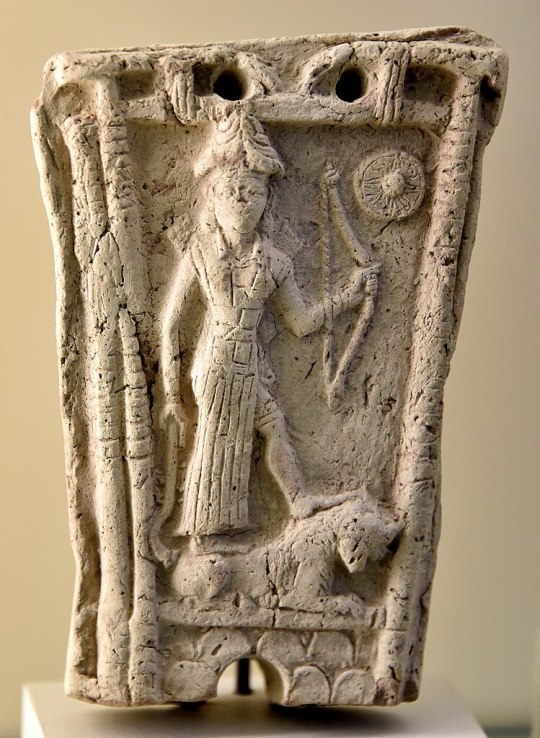
An Old Babylonian plaque depicting armed Inanna (wikimedia commons)
Martial first, marital second?
War and other related affairs will be the first sphere of Inanna’s activity I’ll look into, since it feels like it’s the one least acknowledged online and in various questionable publications. Ilona Zsolnay points out that this even extends to serious scholarship to a degree, and that as a result her military side is arguably understudied (Ištar, Goddess of War, Pacifier of Kings: An Analysis of Ištar’s Martial Role in the Maledictory Sections of the Assyrian Royal Inscriptions, p. 389). The oldest direct evidence for the warlike role of Inanna are Early Dynastic theophoric names such as Inanna-ursag, “Inanna is a warrior”. Further examples are provided by a variety of both Sumerian and Akkadian sources from across the second half of the third millennium BCE. This means it’s actually slightly older than the first evidence for an association with love and eroticism, which can only be dated with certainty to the Old Akkadian period when it is directly mentioned for the first time, specifically in love incantations (Joan Goodnick Westenholz, Inanna and Ishtar in the Babylonian World, p. 336).
Deities associated with combat were anything but uncommon in Mesopotamia. There was no singular war god - Ninurta, Nergal, Zababa, Ilaba, Tishpak and an entire host of other figures, some recognized all across the region, some limited to one specific area or even just a single city, shared a warlike disposition. Naturally, the details could vary - Ninurta was essentially an avenger restoring order disturbed by supernatural threats, Nergal was a war god because he was associated with just about anything pertaining to inflicting death, and so on.
All the examples I’ve listed are male, but similar roles are also attested for multiple goddesses, not just Inanna. Those include closely related deities like Annunitum or Belet-ekallim, most of her foreign counterparts, the astral deity Ninisanna (more on this figure later), but also firmly independent examples like Ninisina and the Middle Euphrates slash Ugaritic Anat (Ilona Zsolnay, Do Divine Structures of Gender Mirror Mortal Structures of Gender?, p. 114).
The god list An = Anum preserves a whole series of epithets affirming Inanna’s warlike character - Ninugnim, “lady of the army”; Ninšenšena, “lady of battle”; Ninmea, “lady of combat”; Ninintena, “lady of warriorhood” (tablet IV, lines 20-23; Wilfred G. Lambert and Ryan D. Winters, An = Anum and Related Lists, p.162). It is also well represented in literary texts. She is a “destroyer of lands” (kurgulgul) in Ninmesharra, for instance (Markham J. Geller, The Free Library Inanna Prism Reconsidered, p. 93).
At least some of the terms employed to describe Inanna in other literary compositions were strongly masculine-coded, if not outright masculine. The poem Agušaya characterizes her as possessing “manliness” (zikrūtu) and “heroism” (eṭlūtu; this word can also refer to youthful masculinity, see Analyzing Constructs…, p. 471) and calls her a “hero” (qurādu). Another example, a hymn dated to the reign of Third Dynasty of Ur or First Dynasty of Isin opens with an incredibly memorable line - “O returning manly hero, Inanna the lady (...)” (or, to follow Thorkild Jacobsen’s older translation, which involves some gap filling - “O you Amazon, queen—from days of yore, paladin, hero, soldier”; The Free Library… p. 93).
A little bit of context is necessary here: while “heroism” might seem neutral to at least some modern readers, in ancient Mesopotamia it was seen as a masculine trait (Ištar, Goddess of War…, p. 392-393). It’s worth noting that eṭlūtum, which you’ve seen translated as “heroism” above can be translated in other context as “youthful masculinity” (Analyzing Constructs…, p. 471). On the other hand, while zikrūtu is derived from zikāru, “male”, it might refer both straightforwardly to masculinity and more abstractly to heroism (Ištar, Goddess of War…, p. 397).
However, the same hymn which calls Inanna a “manly hero” refers to her with a variety of feminine titles like nugig. There’s even an Emesal gašan (“lady”) in there, you really can’t get much more feminine than that (The Free Library… p. 89). On top of that, about a half of the composition is a fairly standard Dumuzi romance routine (The Free Library… p. 90-91; more on what that entails later, for now it will suffice to say that not gender nonconformity).
This is a recurring pattern, arguably - Agušaya, where masculine traits are attributed to Inanna over and over again, still firmly refers to her as a feminine figure (“daughter”, “goddess”, “queen”, “princess”, “mistress”, “lioness” and so on; Benjamin R. Foster, Before the Muses: an Anthology of Akkadian Literature, p. 160 and passim). In other words, the assignment of a clearly masculine sphere of activity and titles related to it doesn’t really mean Inanna is not presented as feminine in the same compositions.
How to explain this phenomenon? In Mesopotamian thought both femininity and masculinity were understood as me, ie. divinely ordained principles regulating the functioning of the cosmos. In modern terms, these labels as they were used in literary texts arguably had more to do with gender and gender roles than strictly speaking with biological sex (Ištar, Goddess of War…, p. 391-392). Ilona Zsolnay on this basis concludes that Inanna, while demonstrably regarded as a feminine figure, took on a masculine role in military context (Ištar, Goddess of War…, p. 401). This is hardly an uncommon view in scholarship (The Free Library…, p. 93; On Language…, p. 243).
In other words, it can be argued that when the lyrical voice in Agušaya declares that “there is a certain hero, she is unique” (i-ba-aš-ši iš-ta-ta qú-ra-du; Before the Muses…, p. 98) the unique quality is, essentially, that Inanna fulfills a strongly masculine coded role - that of a “hero”, understood as a youthful, aggressive masculine figure - despite being female.
It should be noted that the ideal image of a person characterized by youthful masculinity went beyond just warfare, or abstract heroic adventures, though. The Song of the Hoe indicates that willingness to perform manual work in the fields was yet another aspect of it (Ilona Zsolnay, Gender and Sexuality: Ancient Near East, p. 277). This, as far as I know, was never attributed to Inanna.
Furthermore, the sort of youthful, aggressive masculinity we’re talking about here was regarded as something fleeting and temporary for the most part (at least when it came to humans; deities are obviously a very different story), and a very different image of male gender roles emerges from texts such as Instruction of Shuruppak, which extol a peaceful, reserved demeanor and the ability to provide for one’s family as masculine virtues instead (Gender and Sexuality…, p. 277-278). It might be worth pointing out that Sumerian outright uses two different terms to designate “youthful” (namguruš) and “senior” (namabba) masculinity (Gender and Sexuality…, p. 275); the general term for masculinity, namnitah, is incredibly rare in comparison (Gender and Sexuality…, p. 276-277).
It needs to be pointed out that a further Sumerian term sometimes translated as “manliness” - šul, which occurs for example in the hymn mentioned above - might actually be gender neutral; in addition to being used to describe mortal young men and Inanna, it was also applied as an epithet to the goddess Bau, who demonstrably was not regarded as a masculine figure; she didn’t even share Inanna’s warlike character (Analyzing Constructs…, p. 471). Perhaps the original nuance simply escapes us - could it be that šul was not strictly speaking masculinity, but some more abstract quality which was simply more commonly associated with men?
In any case, it’s hard to argue that Inanna really encompasses the entire concept of masculinity as the Mesopotamians understood it. At the same time, it is impossible to deny that she was portrayed as responsible for - and enthusiastically engaged in - spheres of activity which were seen as firmly masculine, and could accordingly be described with terms associated with them. Therefore, it would be more than suitable to describe her as gender nonconforming - at least when she was specifically portrayed as warlike.
Perhaps Dennis Pardee was onto something when he completely sincerely described Anat, who despite being firmly a female figure similarly engaged in masculine pursuits (not only war, but also hunting) as a “tomboy goddess” (Ritual and Cult at Ugarit, p. 274).
These observations only remain firmly correct as long as we assume that gender roles are a concept fully applicable to deities, of course - I’ll explore in more detail later whether this was necessarily true.
Royal curses and legal loopholes
A different side of Inanna as a war deity which nonetheless still has a lot to do with the topic of this article comes to the fore in curse formulas from royal inscriptions. Their contents are not quite as straightforward as imploring her to personally intervene on the battlefield. Rather, she was supposed to make the enemy unable to partake in warfare properly (Ištar, Goddess of War…, p. 390). Investigating how this process was imagined will shed additional light on how the Mesopotamians viewed masculinity, and especially the intersection between masculinity and military affairs.
The formulas under discussion start to appear in the second half of the second millennium BCE, with the earliest example identified in an inscription of the Middle Assyrian king Tukultī-Ninurta I (Gina Konstantopoulos, My Men Have Become Women, and My Women Men: Gender, Identity, and Cursing in Mesopotamia, p. 363). He implored the goddess to punish his enemies by turning them into women (zikrūssu sinnisāniš) - or rather, by turning their masculinity into femininity, or at the very least some sort of non-masculine quality. The first option was the conventional translation for a while, but sinništu would be used instead of the much more uncommon sinnišānu if it was that straightforward. Interpreting it as “femininity” would parallel the use of zikrūti, “masculinity”, in place of zikaru, “man”.
There are two further possible alternatives, which I find less plausible myself, but which nonetheless need to be discussed. One is that sinnišānu designated a specific class of women. Furthermore, there is also some evidence - lexical list entry from ḪAR.GUD, to be specific - that sinnisānu might have been a synonym of assinnu, a type of undeniably AMAB, but possibly gender nonconforming, cultic performer (in older literature erroneously translated as “eunuch” despite lack of evidence; the second most beloved vintage baseless translation for any cultic terms after “sacred prostitute”, an invention of Herodotus), in which case the curse would involve something like “changing his masculinity in the manner of a sinnisānu” (Ištar, Goddess of War…, p. 394-396). However, Zsolnay herself subsequently published a detailed study of the assinnu, The Misconstrued Role of the assinnu in Ancient Near Eastern Prophecy, which casts her earlier proposal into doubt, as the perception of the assinnu as a figure lacking conventional masculinity might be erroneous. I’ll return to this point later. For now, it will suffice to say that on grammatical grounds and due to parallels in other similar maledictions, “masculinity into femininity” seems to be the most straightforward to me in this case.
The “genderbending” tends to be mentioned alongside the destruction of one’s weapons (My Men Have…, p. 363). This is not accidental - martial prowess, “heroism” and even the ability to bear weapons were quintessential masculine qualities; a man deprived of his masculinity would inevitably be unable to possess them. The masculine coding of weaponry was so strong that an erection could be metaphorically compared to drawing a bow (Ištar, Goddess of War…, p. 395).
Zsolnay points out the reversal of gender in curses is also coupled with other reversals: Inanna is also supposed to “establish” (liškun) the defeat (abikti) of the target of the curses - a future king who fails to uphold his duties - which constitutes a reversal of an idiom common in royal inscriptions celebrating victory (abikti iškun). The potential monarch will also be unable to face the enemy as a result of her intervention - yet again a reversal of a mainstay of royal declarations. The majesty and heroism of a king were supposed to scare enemies, who would inevitably prostrate themselves when faced by him on the battlefield (Ištar, Goddess of War…, p. 396-397).
It is safe to say the goal of invoking Inanna in the discussed formulas was to render the target powerless. (Ištar, Goddess of War…, p. 396; My Men Have…, p. 366). Furthermore, they evoke a fear widespread in cuneiform sources, that of the loss of potency, which sometimes took forms akin to Koro syndrome or the infamous penis theft passages from Malleus Maleficarum (My Men Have…, p. 367). It is worth noting that male impotence could specifically be described as being “like a woman” (kīma sinništi/GIM SAL; Ištar, Goddess of War…, p. 395).
Gina Konstantopoulos argues that references to Inanna “genderbening” others occur in a different context in a variety of literary texts, for example in the Epic of Erra, where they’re only meant to highlight the extent of her supernatural ability. She also suggests that more general references to swapping left and right sides around, for example in Enki and the World Order, are further examples, as they “echo(...) the language of birth incantations” which ritually assigned the gender role to a child (My Men Have…, p. 368). She also sees the passage from the Epic of Gilgamesh describing the fates of various individuals who crossed her path and ended up transformed into animals as a result as a more distant parallel of the curse formulas (My Men Have…, p. 369). However, it needs to be pointed out this sort of shapeshifting is almost unparalleled in Mesopotamian literature (Frans Wiggermann, Hybrid creatures A. Philological. In Mesopotamia, p. 237), and none of the few examples involve a change of gender. The fact that the "genderbending" passages generally reflect a fear of loss of agency (especially on the battlefield) or potency, and by extension of independence tied to masculine gender roles, explains why they virtually never describe the opposite scenario, a mortal woman being placed in a masculine role through supernatural means as punishment (My Men Have…, p. 370). It might be worth pointing out that a long sequence of seemingly contradictory duties involving reversals is also ascribed to Inanna in a particularly complex Old Babylonian hymn (Michael P. Streck, Nathan Wasserman, The Man is Like a Woman, the Maiden is a Young Man. A new edition of Ištar-Louvre (Tab. I-II), p. 2-3). It also contains a rare case of bestowing masculine qualities upon women: “the man is like a woman, the maiden is like a young man” (zikrum sinništeš ardatu eṭel; The Man is Like…, p. 5). However, the context is not identical to the “genderbening” curses. The text is agreed to describe a performance during a specific festival. Other passages explicitly refer to crossdressing and rituals themed around reversal (šubalkutma šipru, "behavior is turned upside down"; The Man is Like…, p. 6). Furthermore, grammatical forms of verbs do not indicate a full reversal of gender (The Man is Like…, p. 31). Overall, I agree with Timothy D. Leonard’s cautious remark that in this context only religiously motivated temporary reversal of gender roles occurs, and we cannot use the passage to make far reaching conclusions about the participants’ identity (Ištar in Ḫatti…, p. 298).
It’s important to bear in mind that a performance involving crossdressing won’t necessarily involve people who are otherwise gender nonconforming, and it doesn’t necessarily have anything to do with the sexuality of the performer. While I typically avoid bringing up parallels from other cultures and time periods as evidence, I feel like this is illustrated quite well by the case of shirabyōshi, a type of female performer popular in Japan roughly from the second half of the Heian period to the late Kamakura period.
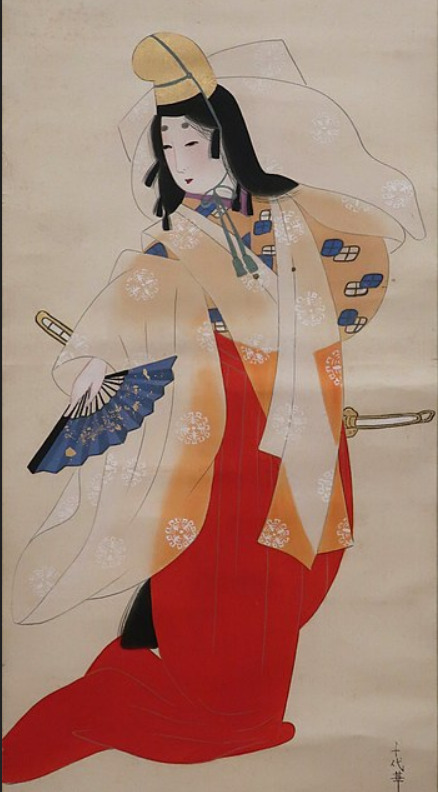
A 20th century depiction of a shirabyōshi (wikimedia commons)
They performed essentially in male formal wear, and with swords at their waists; their performance was outright called a “male dance” (Roberta Strippoli, Dancer, Nun, Ghost, Goddess. The Legend of Giō and Hotoke in Japanese Literature, Theater, Visual Arts, and Cultural Heritage, p. 28). Genpei jōsuiki nonetheless states that famous shirabyōshi were essentially the Japanese answer to the most famous historical Chinese beauties like Wang Zhaojun or Yang Guifei (Dancer, Nun…, p. 27-28). In other words, while the shirabyōshi crossdressed, they were simultaneously held to be paragons of femininity.
Putting crossdressing aside, it’s worth noting women taking masculine roles are additionally attested in legal context in ancient Mesopotamia, though only in an incredibly specific scenario. A man who lacked male heirs could essentially legally declare his daughter a son, so that she would be able to have the privileges as a man would with regards to inheritance. For example, in a text from Emar a certain mr. Aḫu-ṭāb formally made his daughter Alnašuwa his heir due to having no other descendants, and explained that as a result she will have to be “both male and female” (NITA ù MUNUS) - effectively both a son and a daughter - to keep the process legitimate. Once Alnašuwa got married, her newfound status as a son of her father was legally transferred to her husband, though. Evidently no supernatural powers were involved at any stage, only an uncommon, but fully legitimate, legal procedure (My Men Have…, p. 370-372). It should be noted that when male by proxy, Alnašuwa was explicitly not expected to perform any military roles - her father only placed such an exception on potential grandsons (My Men Have…, p. 370). Therefore, the temporary masculine role she was granted was arguably not the same as the sort of masculinity curses were supposed to take away, or the sort Inanna could claim for herself to a degree.
Luminous beards and genderfluid planets: the astral Inanna (and her peers)

A standard Mesopotamian depiction of the planet Venus (Dilbat) on a late Kassite boundary stone (wikimedia commons)
Male in the morning, female in the evening (or the other way round)?
While the inquiry into Inanna’s military aspect revealed a fair amount of evidence for gender nonconformity, it would be disingenuous on my part to end the article on just that. A slightly different phenomenon is documented with regards to her astral side - or perhaps with regards to the astral side of multiple deities, to be more precise.
To begin with, in Mesopotamian astrology Venus (Dilbat) was one of the two astral bodies which were described as possessing two genders, the other being Mercury (Erica Reiner, Astral Magic in Babylonia, p. 6; interestingly, it doesn’t seem any deity associated with Mercury acquired this characteristic unless you want to count a possible late case from outside Mesopotamia). The primary sources indicate that this reflected the fact Venus is both the morning star and the evening star, though there was no agreement between ancient astronomers which one of them was feminine and which masculine (Ulla Koch-Westenholz, Mesopotamian Astrology. An Introduction to Babylonian and Assyrian Celestial Divination, p. 40). We even have a case of a single astrologer, a certain Nabû-ahhe-eriba, alternating between both options in his personal letters (p. 126). It needs to be pointed out that while some interest in stars and planets might already be attested in Early Dynastic sources, its scope was evidently quite limited and astrology didn’t develop yet (Mesopotamian Astrology…, p. 32). No astrological texts predate the Old Babylonian period, and most of the early ones are preoccupied with the moon (p. 36-37), though the earliest evidence for astrological interest in Venus are roughly contemporary with them (p. 40). Astronomical observations of this planet were certainly already conducted for divinatory purposes during the reign of Ammisaduqa, and by the seventh century BCE experts were well familiar with its cycle and made predictions on this basis (p. 126).
Inanna’s association with Venus predates the dawn of astrology by well over a millennium. It likely goes back all the way up to the Uruk period - if not earlier, but that sort of speculation is moot because you can’t talk about Mesopotamian theology with no textual sources, and these are fundamentally not something available before the advent of writing. The earliest evidence are archaic administrative texts which separately record offerings for Inanna hud, “Inanna the morning” and Inanna sig, “Inanna the evening” (Inanna and Ishtar…, p. 334-335). However, it is impossible to tell if this was already reflected in any sort of ambiguity or fluidity of gender. It also needs to be noted the archaic text records two more epithets, Inanna NUN, possibly “princely Inanna” (p. 334; this is actually the single oldest one) and Inanna KUR, possibly a forerunner of later title ninkurkurra, “lady of the lands” (p. 335). Therefore, Inanna was arguably already more than just a deity associated with Venus.
It’s up for debate to which degree an astral body was seen as identical with the corresponding deity in later periods (Spencer J. Allen, The Splintered Divine. A Study of Ištar, Baal, and Yahweh Divine Names and Divine Multiplicity in the Ancient Near East, p. 41-42). There is evidence that Inanna and the planet Venus could be viewed as separate, similarly to how the moon observed in the sky could be treated as distinct from the moon god Sin (p. 40). The most commonly cited piece of evidence is that astrological texts fairly consistently employ the name Dilbat to refer to the planet instead of Inanna’s name or one of the logograms used to represent it, like the numeral 15 (p. 42).
Regardless of these concerns, one specific tidbit pertaining to astrological comments on Venus is held as particularly important for possible ambiguity or fluidity of Inanna’s gender, and even lead to arguments that masculine depictions might be out there: the planet can be described as bearded (Astral Magic…, p. 6). Omens attesting this are most notably listed in the compendium Iqqur īpuš (Erica Reiner, David Pingree, Babylonian Planetary Omens vol. 3, p. 10-11). it should be noted that the planet is referred to only as Dilbat in this context (see ex. Babylonian Planetary…, p. 105 for an example). I’m only aware of two texts where this feature is transferred to the corresponding deity: the syncretic hymn to Nanaya and Ashurbanipal’s hymn to Ishtar of Nineveh. Is the beard really a beard, though? Not necessarily, as it turns out.
The passage from the hymn of Ashurbanipal has been recently discussed by Takayoshi M. Oshima and Alison Acker Gruseke (She Walks in Beauty: an Iconographic Study of the Goddess in a Nimbus, p. 62-63). They point out that ultimately there are no certain iconographic representations of bearded Ishtar. There are a few proposed ones on cylinder seals but this is a minority position relying on doubtful exegesis of every strand of hair in sight; no example has anything resembling the “classic” Mesopotamian beard. I’ll return to this problem in a bit.
In any case, the authors of the aforementioned paper argue the key to interpreting the passage is the fact that the reference to the beard (or rather beards in the plural) occurs in an enumeration of strictly astral, luminous characteristics, like being “clothed in brilliance” (namrīrī ḫalāpu). Furthermore, they identify a parallel in the Great Hymn to Shamash: the rays of the sun are described as “beards” (ziqnāt), and occur in parallel with “splendor” (šalummatu) and “lights” (namrīrū). Therefore, they assume the “beard” might be a metaphorical term for a ray of light, rather than facial hair. This would match actually attested depictions - in the first millennium BCE, especially in Assyria, images of a goddess surrounded by rays of light or a large halo of sorts are very common.

A goddess surrounded by a halo on a Neo-Assyrian seal (wikimedia commons)
Perhaps most importantly, this interpretation is also confirmed by the astronomical texts which kickstarted the discussion. The phrase ziqna zaqānu, “to have a beard”, is explained multiple times as reflection of an unusual luminosity when applied to Venus. The authors additionally argue that it is possible the use of the term “beard” was originally tied to the triangular portions of the emblems of Inanna and her twin (which indeed represent the luminosity of Venus and the sun) to explain why a plurality of “beards” is relatively common in the discussed descriptions (p. 64).
As I said before, the second example is a hymn to Nanaya. It’s easily one of my favorite works of Mesopotamian literature, and a few years ago it kickstarted my interest in its “protagonist”, but tragically most of it is completely irrelevant to this article. The gist of it is fairly simple: the entire composition is written in first person, and in each strophe Nanaya claims the prerogatives of another deity before reasserting herself: “still I am Nanaya” (Goddesses in Context…, p. 116-117). The “borrowed” attributes vary from abstract cosmic powers to breast size. The deities they are linked with range from the most major members of the pantheon (Inanna, Gula, Ishara, Bau…) through spouses of major deities (Shala, Damkina…) to obscure oddities (Manzat, the personified rainbow); there’s even one who’s otherwise entirely unknown, Šuluḫḫītum (for a full table see Erica Reiner’s A Sumero-Akkadian Hymn of Nanâ, p. 232).
As expected, the strophe relevant to the current topic is the one focused on Inanna, in which Nanaya proudly exclaims “I have a beard (ziqna zaqānu) in Babylon”, in between claiming to have “heavy breasts in Daduni” (Reiner notes this is not actually an attested attribute of Inanna, and suggests the line might be a pun on the name of the city mentioned in it, Daduni, and the word dādu) and appropriating Inanna’s family tree for herself (A Sumero-Akkadian…, p. 233).
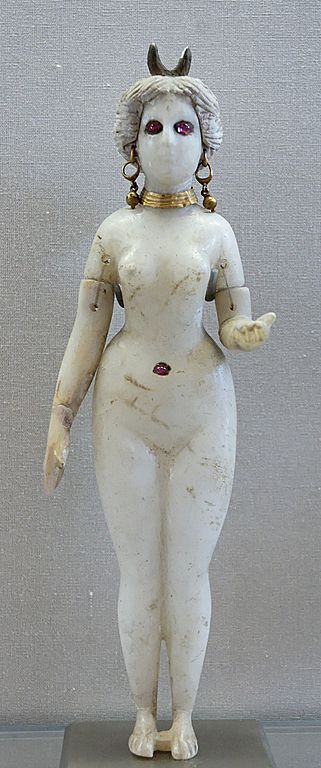
A possible late depiction of Nanaya (wikimedia commons)
It needs to be stressed that Nanaya’s gender shows no signs of ambiguity anywhere; quite the opposite, she was the “quintessence of womanhood“ (Olga Drewnowska-Rymarz, Mesopotamian Goddess Nanāja, p. 156). I would argue the most notable case of something along the lines of gender nonconformity in a source focused on her occurs in the sole known example of a love poem starring her and her sparsely attested Old Babylonian spouse Muati.
Muati is asked to intercede with Nanaya on behalf of a petitioner (Before the Muses…, p. 160), which usually was the role performed of the wife of a major male deity (or by Ninshubur in Inanna’s case; Goddesses in Context…, p. 273). Sadly, despite recently surveying most publications mentioning Muati I haven’t found any substantial discussion of this unique passage, and I’m not aware of any parallels involving other couples where the wife was a more important deity than the husband (like Ninisina and Pabilsag).
A further issue for the beard passage is that Nanaya had no connection to Venus to speak of - she could be described as luminous, but she was only compared to the sun, the moon, and unspecified stars (Mesopotamian Goddess Nanāja, p. 153-155).
Given that the hymn most likely dates to the early first millennium BCE (Goddesses in Context…, p. 116), yet another problem for the older interpretation is that the city of Babylon at this point in time is probably the single worst place for seeking any sort of gender ambiguity when it comes to Inanna.
After the end of the Kassite period, Babylon became the epicenter of Marduk-centric theological ventures which famously culminated in the composition of Enuma Elish. What is less well known is that as a part of the same process, attempts were made to essentially fuse Bēlet-Bābili (“lady of Babylon”) - the main (but not only) local form of Inanna, regarded as distinct from Inanna of Uruk (the “default” Inanna) - with Zarpanitu (The Pantheon…, p. 75-76). Zarpanitu was effectively the definition of an indistinct spouse of another deity - there’s not much to say about her character other than that she was Marduk’s wife (Goddesses in Context…, p. 92-93). Accordingly, it is hard to imagine that the contemporary “lady of Babylon” would be portrayed as bearded.
During the reign of Nabu-shuma-ishkun in the eighth century BCE an attempt to extend the new dogma to Inanna of Uruk was made, though this was evidently considered too much for contemporary audiences. Multiple sources display varying degrees of opposition to replacement of Inanna in the Eanna by a goddess who didn’t belong there, presumably either Zarpanitu or at the very least Bēlet-Bābili after “Zarpanituification” so severe she no longer bore a sufficient resemblance to her Urukuean colleague (The Pantheon…, p. 76-77). Inanna of Uruk was restored during the reign of Nebuchadnezzar II, who curiously affirmed that her temple was temporarily turned into the sanctuary of an “inappropriate goddess” (The Pantheon…, p. 131). However, the Marduk-centric ventures left a lasting negative impression in Uruk nonetheless, and in the long run lead to quite extreme reactions, culminating in the establishment of an active cult of Anu for the first time, but that’s another story (I might consider covering it in detail if there’s interest).
To go back to the hymn to Nanaya one last time, it’s interesting to note that a single copy seems to substitute ziqna zaqānu for zik-ra-[...], possibly a leftover of zikrāku, “manly”. Takayoshi M. Oshima and Alison Acker Gruseke presume this is only a scribal mistake, since this heavily damaged exemplar is rife with typos in general (She Walks…, p. 63), though I’m curious if perhaps a reference to the military character of Inanna herself or Annunitum was meant. This would line up with evidence from Babylon to a certain degree, since through the first millennium BCE Annunitum was worshiped there in her own temple (Goddesses in Context…, p. 105-106). However, in the light of what is known about this unique variant, it’s best to assume that it is indeed a typo and the hymn simply refers to luminosity.
While no textual sources earlier (or later, for that matter) than the two hymns discussed above attribute a beard to Inanna (Zainab Bahrani, Women of Babylon. Gender and Representation in Mesopotamia, p. 182), the most commonly cited example of a seal with a supposedly bearded depiction is considerably earlier (Ur III, so roughly 2100 BCE, long before any references to “bearded Venus”). It comes from the Umma area judging from the name and title of its owner, a certain Lu-Igalima, a lumaḫ priest of Ninibgal (“lady of the [temple] Ibgal”, ie. Inanna’s temple in Umma). However, Julia M. Asher-Greve points out that the beard is likely to be a strand of hair, since contemporary parallels supporting this interpretation are available, for example a seal of a priest of Inanna from Nippur, Lugalengardu. Furthermore, she notes that the seal cutter was seemingly inexperienced, since the detail is all around dodgy, for example Inanna’s foot seems to be merged with the head of the lion she stands on (Goddesses in Context…, p. 208). Looking at the two images side by side, I think this is a compelling argument, since the beard doesn’t really look like, well, a typical Mesopotamian beard, while the hairdo on the Nippur seal is indeed similar:
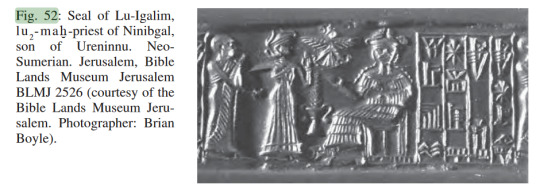

Both images are screencaps from Goddesses in Context, p. 403; reproduced here for educational purposes only.
While I think the beard-critical arguments are sound, this is not the only possible kind of depiction of Inanna argued to reflect the fluidity of gender attributed to the planet Venus.
Paul-Alain Beaulieu notes that an inscription of Nebuchadnezzar with a dedication to Inanna of Uruk she might be called both the lamassu, ie. “protective goddess”, of Uruk and šēdu, ie. “protective genius”, of Eanna; the latter is an invariably masculine term. However, it is not entirely clear if the lamassu and šēdu invoked here are both really a partially masculine Ishtar, since there’s a degree of ambiguity involved in the concept of protective deity or deities of a temple - while there’s evidence for outright identification with the main deity of a given house of worship, they could also be separate, though closely related, and Beaulieu ultimately remains uncertain which option is more plausible here (The Pantheon…, p. 137-138). He also points out that there’s some late evidence for apotropaic figures with two faces, male and female, which were supposed to represent a šēdu+lamassu pair, but rules out the possibility that these have anything to do with Ishtar, since two faces are virtually never her attribute (The Pantheon…, p. 137). There is a single possible exception from this rule, but it’s an outlier so puzzling it’s hard to count it. A single Neo-Assyrian text from Nineveh (KAR 307) describes Ishtar of Nineveh (there is a reason why I abstain from using the name Inanna here, as you’ll see later) as four-eyed, which Beaulieu suggests might mean the deity had a male face and a female face. The same source also states that Ishtar of Nineveh is Tiamat and has “upper parts of Bel” and “lower parts of Ninlil”, though (The Pantheon…, p. 137), so it’s probably best not to think of it too much - Tiamat is demonstrably not a figure of much importance in general, let alone in the context of Inanna-centric considerations.
The same text has been interpreted differently by Wilfred G. Lambert. He concludes that it’s ultimately probably an esoteric Enuma Elish commentary and that it might have been cobbled together by a scribe from snippers of unrelated, contradictory sources (Babylonian Creation Myths, p. 245). If correct, this would disprove Beaulieu’s proposal, since the four eyes would simply reflect the description of Marduk (Bel) in EE (tablet I, line 55: “Four were his eyes, four his ears”). I lean towards Lambert’s interpretation myself; the reference to Tiamat is the strongest argument, outside EE and derived commentaries she was basically a non-entity. I’ll go back to the topic of Ishtar of Nineveh later, though - there is a slim possibility that two faces might really be meant, though this would take us further away from Inanna, all the way up to ancient Anatolia.
As a final curiosity it’s worth pointing out that while this is entirely unrelated to the discussed matter, KAR 307 is also the same text which (in)famously states Tiamat has the form of a dromedary. As odd as that sounds, it’s much easier to explain when you realize that the Akkadian term for this animal, when broken down to individual logograms, could be interpreted as “donkey of the sea” - and Tiamat’s name was derived from the ordinary Akkadian word “sea” (Babylonian Creation…, p. 246).
The Red Lady of Heaven, my king
While both the bearded and two faced Inannas are likely to be mirages, this doesn’t mean the dual gender of Venus was not reflected in the world of gods. The result was a bit more complex than the existence of a male Inanna, though.
In addition to being Inanna’s astral attribute, Venus simultaneously could be personified under the name Ninsianna. Ninsianna could be treated as a title of Inanna - this is attested for example in a hymn from the reign of Iddin-Dagan of Isin - but unless explicitly stated, should be treated as a separate deity. This is evident especially in sources from Larsa, where the two were worshiped entirely separately from each other (Goddesses in Context…, p. 92).
Ninsianna’s name can be literally translated as “red lady of heaven” (Goddesses in Context…, p. 86), though as I already explained earlier, nin is actually gender neutral - “red lord of heaven” is theoretically equally valid. And, as a matter of fact, it is necessary to employ the latter translation in some cases - an inscription of Rim-Sin I refers to Ninsianna with the firmly masculine title lugal, “king” (Wolfgang Heimpel, Ninsiana, p. 488).
It seems safe to say that in Ninsianna’s case we’re essentially dealing with a deity who truly was like Venus. Timothy D. Leonard stresses that while frequently employed in past scholarship, the labels “hermaphroditic” and “androgynous” do not describe the phenomenon accurately. What the sources actually present is a deity who switches between a male form and a female one (Ištar in Ḫatti…, p. 226). In other words, if we are to apply a contemporary label, it seems optimal to say Ninsianna was perceived as genderfluid.
Interestingly, though, it seems that Ninsianna’s gender varied by location as well (Goddesses in Context…, p. 92). The worship of feminine Ninsianna is attested for example in Nippur (Goddesses in Context…, p. 101) and Uruk (Goddesses in Context…, p. 126), masculine - in Sippar-Amnanum, Girsu and Ur (Ninsiana, p. 488-489). No study I went through speculated what the reasons behind this situation might have been. Was Ninsianna’s gender locally viewed as less flexible than the discussed theological texts indicate? Were specific sanctuaries dedicated only to a specific aspect of this deity - only the “morning” Ninsianna or “evening” Ninsianna? For the time being these questions must remain unanswered in most cases.
There’s a single case where the preference for feminine Ninsianna was probably influenced by an unparalleled haphazard theological innovation, though - in Isin in the early second millennium BCE the local dynasty lost control over Uruk, and as a result access to royal legitimacy granted symbolically by Inanna. To remedy that, the tutelary goddess of their capital was furnished with similar qualifications through a leap of logic relying on one hand on the close association between Inanna and Ninsianna, and on the other on the phonetic (but not etymological) similarity between the names of Ninisina and Ninsianna (Goddesses in Context…, p. 86). As far as I know, this did not influence the perception of Ninisina’s gender in any shape or form, though.
An interesting extension of the phenomenon of Ninsianna’s gender is this deity’s association with an even more enigmatic figure, Kabta. Only two things can be established about Kabta with certainty: that they were an astral deity, and that they were associated in some way with Ninsianna; even their gender is uncertain (Wilfred G. Lambert, Kabta, p. 284).
It might be worth pointing out that as a result Kabta and Ninsianna seem to constitute the first case of a Mesopotamian deity of variable (Ninsianna) or uncertain (Kabta) gender being referred to with a neutral pronoun in an Assyriological publication - Ryan D. Winters’ commentary on their entries in a variety of god lists employs a singular they (An = Anum…, p. 34):

Wilfred G. Lambert argued that the two were spouses (Kabta, p. 284). More recently the same point has been made by Winters based on Kabta’s placement after Ninsianna in An = Anum, and directly before Dumuzi in an Old Babylonian forerunner of this list (An = Anum…, p. 22). However, I feel obliged to point out that An = Anum, which fairly consistently identifies spouses as such, does not actually specify the nature of the connection between the two. Once the enumeration of Ninsianna’s names finishes, the list simply switches to Kabta’s (An = Anum…, p. 170).
In another god list, which is rather uncreatively referred to as “shorter An = Anum” due to sharing the first line with its more famous “relative” but lacking its sheer scope, names of Kabta are listed among designations for Inanna’s astral forms, which would have interesting implications for the nature of the supposed relationship between them and Ninsianna (An = Anum…, p. 34). Furthermore, as noted by Jeremiah Peterson, both of them, as well as Kabta’s alternate name Maḫdianna and a further astral deity, Timua, are also glossed as Ištar kakkabi - in this case according to him likely a generic moniker “goddess of the star” as opposed to “Ishtar of the star” - in a variety of lexical lists (God Lists from Old Babylonian Nippur, p. 58).
In the light of the somewhat confusing evidence summarized above, further inquiries into both Kabta’s character and the nature of the connection between them and Ninsianna are definitely necessary. Assuming that they were spouses, how did theologians who adhered to this view deal with them also being treated as two manifestations of one being instead (I suppose you could easily put a romantic spin on that, to be fair)? Did Kabta’s gender change alongside Ninsianna’s, or perhaps following a different scheme, or was this a characteristic they lacked? Unless new sources emerge, this sadly must remain the domain of speculation.
Ninsianna’s fluid gender also has to be taken into account while discussing one further deity, Pinikir. The discovery of a fragmentary god list in Emar made it possible to establish the latter was regarded as the Hurrian equivalent of the former (Ištar in Ḫatti…, p. 224; note that there seems to be a typo here, the list is identified as An = Anum but it’s actually the Weidner god list). This deity similarly was understood as a personification of Venus (Piotr Taracha, Religions of Second Millennium Anatolia, p. 99) and was in a certain capacity associated with Inanna - however, as it will become evident pretty quickly these weren’t the only analogies with Ninsianna.
Despite appearing in Emar in Hurrian context, Pinikir actually originated to the east of Mesopotamia, in Elam (Ištar in Ḫatti…, p. 223). Her name cannot yet be fully explained due to imperfect understanding of Elamite, but it is clear that the suffix -kir is feminine and means “goddess” (Ištar in Ḫatti…, p. 237; cf. the not particularly creatively named Kiririsha, “great goddess”). Sources from Anatolia recognize Pinikir as an Elamite deity, though direct transfer from one end of the “cuneiform world” to the other is unlikely (Ištar in Ḫatti…, p. 236). Most likely, Hurrians received Pinikir through Mesopotamian intermediaries in the late third or early second millennium BCE, and later introduced this deity further west (Ištar in Ḫatti…, p. 237). We know Mesopotamians were aware of her thanks to the god list Anšar = Anum, where the name occurs among what may or may not be an enumeration of deities regarded as Inanna’s foreign counterparts (An = Anum…, p. 36). For the time being it is not possible to track this process directly, though - it’s all educated guesswork.
While as far as I am aware none of the few Elamite sources dealing with Pinikir provide much theological information about her, and none hint at her gender being anything but feminine, Hurro-Hittite texts from Anatolia indicate that at least in this context, like Ninsianna in Mesopotamia, she came to be seen as a genderfluid deity, sometimes counted among gods, sometimes among goddesses (Gary Beckman, The Goddess Pirinkir and her Ritual from Ḫattuša (CTH 644), p. 25). Firmly feminine Pinikir occurs in a ritual text (KUB 34.102) which refers to her in Hurrian as Allai-Pinikir, “lady Pinikir”; interestingly this is the only case where she is provided with an epithet in any Anatolian source (Ištar in Ḫatti…, p. 211). However, there are examples of ritual texts where Pinikir is listed among male deities (Ištar in Ḫatti…, p. 229). He is also depicted in the procession of gods in the famous Yazilikaya sanctuary in a rather striking attire:
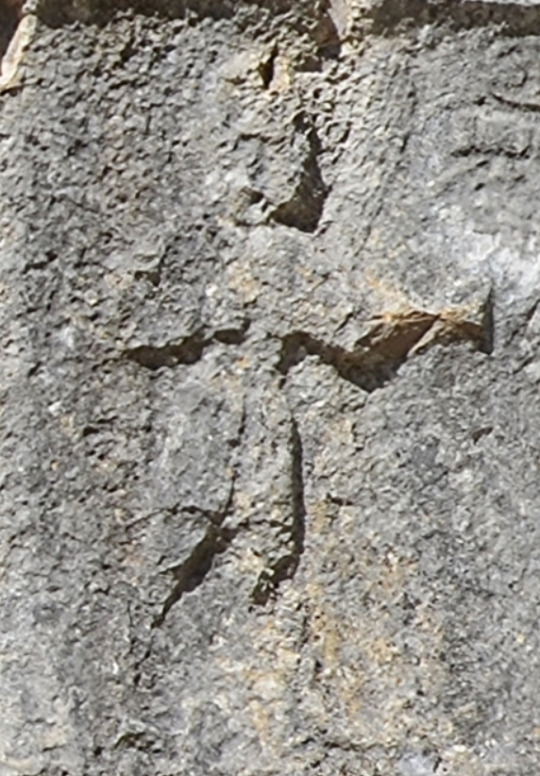
I know, I know, the state of preservation leaves much to be desired (wikimedia commons) This isn’t just any masculine clothing - the outfit is only shared with two other figures depicted in this sanctuary, the sun god Shimige and the Hittite king (The Goddess Pirinkir…, p. 25-26):


Shimige (left; wikimedia commons) and the king (right; also wikimedia commons)
Piotr Taracha argues that it reflects the attire worn by the Hittite king when he fulfilled his religious duties (Religions of…, p. 89); Pinikir’s isn’t identical - it’s only knee length, like the more standard masculine garments - but the skullcap is pretty clearly the same. He is also winged, which is a trait only shared with the moon god and one more figure (more on them in a bit), and likely reflects celestial associations (Ištar in Ḫatti…, p. 211). All the same traits are also preserved on a small figurine of Pinikir from the collection of the MET:
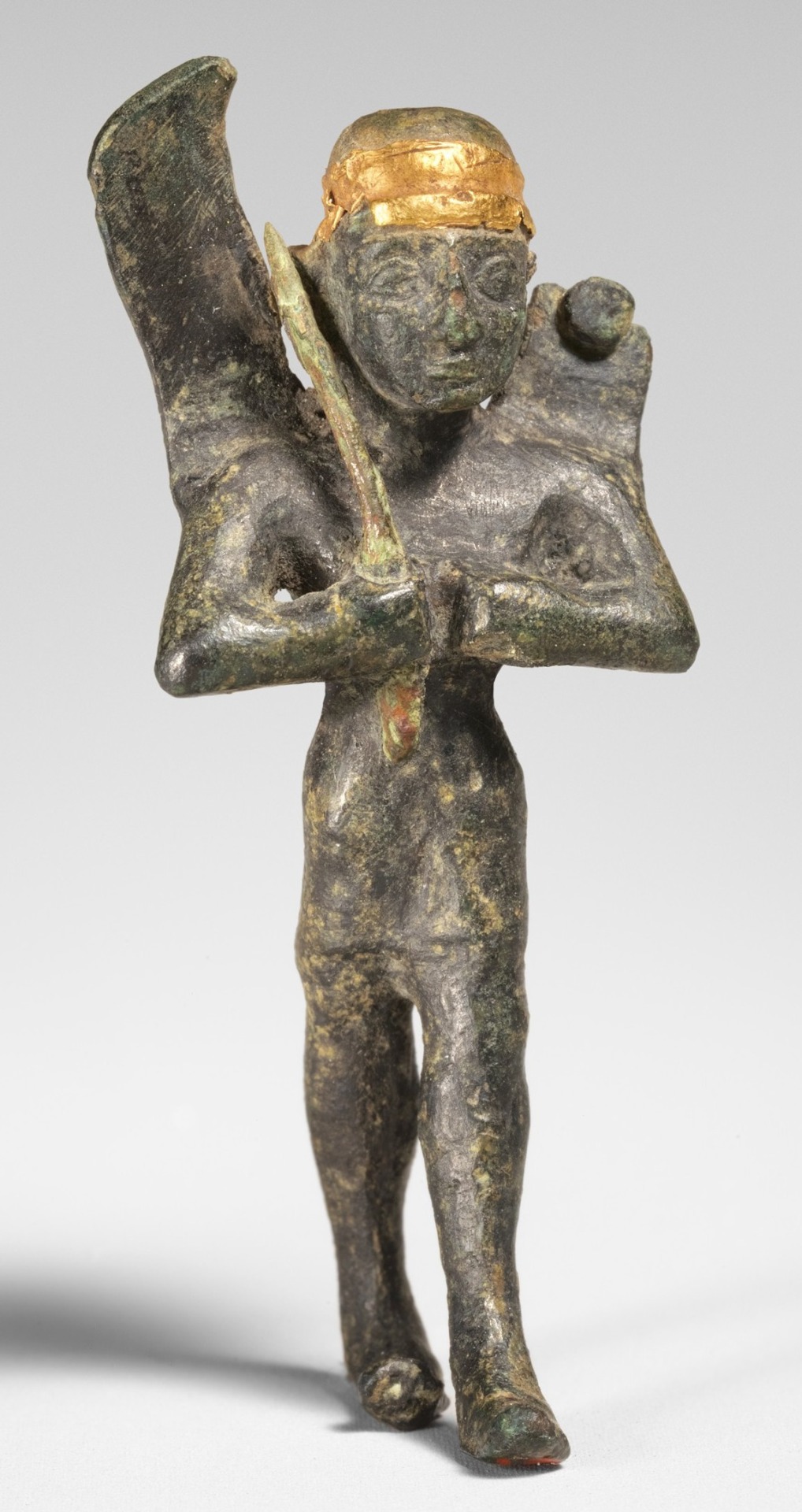
A much better preserved masculine Pinikir (MET)
It’s therefore probably safe to say that the male form had a fairly consistent iconography, which furthermore was patterned on what probably was an archetypal image of masculinity to Hurro-Hittite audiences. The king, whose appearance is reflected in Pinikir’s iconography, was, after all, supposed to be not just any man, but rather the foremost example of idealized masculinity (Mary R. Bachvarova, Wisdom of Former Days: The Manly Hittite King and Foolish Kumarbi, Father of the Gods, p. 83-84).
Since we started this section with beards, we may as well end with them - I feel obliged to point out that no matter how clearly described as masculine, neither Ninsianna nor Pinikir were ever described (let alone depicted) as bearded.
It is difficult for me to estimate to which degree the information about the genderfluidity of Ninsianna and Pinikir can be used to elucidate in which way the association with Venus influenced the perception of Inanna’s gender. However, it seems safe to say the focus on secondary physical characteristics made some authors miss the forest for the trees. I’ll leave it as an open question whether Inanna could be interpreted similarly to her even more Venusian peers, but I’m fairly sure that a metaphorical beard is unlikely to have anything to do with the answer.
Excursus: “the masculinity and femininity of Shaushka”, or when an Ishtar is not Ishtar
Bringing up the masculine Pinikir, and the matter of possible genderfluidity of deities in Mesopotamia and nearby areas, makes it necessary to also discuss Shaushka. The two of them appear mere two lines apart in Anšar = Anum (An = Anum…, p. 36), though they were not closely associated with each other - rather, they were both deities associated with Inanna who happened to belong to the same cultural milieu.
Mx. Worldwide: the transmission of Shaushka across the cuneiform world
Shaushka was originally the tutelary deity of Nineveh, but the attestations span almost the entire “cuneiform world” - from Nineveh in the north to Lagash in the south, from Hattusa in the west, through Ugarit and various inland Syrian cities all the way up to Arrapha in the east. There are simply too many of them to cover everything here.
The oldest known reference to Shaushka (which doubles as the first reference to the city of Nineveh) occurs in a text from the Ur III period. It’s not very thrilling - it’s only an administrative text mentioning the offering of a sheep made on behalf of the king of the Ur III state (Gary Beckman, Ištar of Nineveh Reconsidered, p. 1). The earliest sources render the name as Shausha; the infix -k- which only starts to appear consistently later on is presumed to be an honorific, or less plausibly a diminutive (Ištar in Ḫatti…, p. 55-56). Either way, it is agreed it can be translated simply as “the great one” (Ištar in Ḫatti…, p. 56) - a pretty apt description of its bearer.
Ur III attestations of Shaushka are sparse otherwise: a textile offering in Umma (possibly a garment for a statue), a handful of theophoric names like Ur-Shausha and Geme-Shausha in Lagash, and that’s basically it (Tonia Sharlach, Foreign Influences on the Religion of the Ur III Court, p. 106). Still, it’s probably safe to say it’s one of the examples of a broader pattern of interest in Hurrian religion evident in the courtly documents from this period, and in the appointment of a number of Hurrian diviners to relatively prestigious positions. Whether such experts might have influenced the introduction of Shaushka and other Hurrian deities who entered lower Mesopotamia roughly at the same time (for example Allani from Zimudar or Shuwala from Mardaman) remains an open question (Foreign Influences…, p. 111-114).
A degree of equivalence between Shaushka and Inanna was already recognized in the early second millennium BCE, as evidenced by a tablet from the northern site of Shusharra dated to the reign of Shamshi-Adad which records an offering made to “Ishtar of Nineveh” (Ištar in Ḫatti…, p. 58). However, it might have happened as early as half a millennium earlier, during the Sargonic period - Gary Beckman suggests the identification between the two might have initially occurred simply due to the importance assigned to Inanna by rulers of the Akkadian Empire (Ištar of Nineveh…, p. 2).
Furthermore, a number of later Mesopotamian lexical lists label Shaushka as “Ishtar of Subartu” - a common designation for the core Hurrian areas (Ištar of Nineveh…, p. 2). Meanwhile, Hurrians and cultures influenced by them used the name Ishtar as a logogram to represent Shaushka (Ištar in Ḫatti…, p. 46). Furthermore, they placed Shaushka in Uruk in an adaptation of the Epic of Gilgamesh (Ištar in Ḫatti…, p. 125). One is forced to wonder if perhaps from the Hurrian interpreter’s perspective Inanna was some sort of foreign Shaushka ersatz, not the other way around.
Despite Shaushka’s origin in the Hurrien milieu of northernmost part of Mesopotamia, the bulk of attestations actually come from Hittite Anatolia (Ištar of Nineveh…, p. 2). Kizzuwatna, a kingdom in southeastern Anatolia, was the middleman in this transmission (Ištar in Ḫatti…, p. 95). The earliest evidence for Hittite reception of Shaushka is an oracle text from either the late fifteenth or early fourteenth century BCE (Ištar in Ḫatti, p. 84). However, save for the capital, Hattusa, no major cities were ever identified as cult centers of this deity, and they were seemingly worshiped largely within the southern and eastern periphery of the Hittite empire (Ištar in Ḫatti…, p. 94). Most of the ritual texts Shaushka appears in accordingly appear to have Kizzuwatnean, or at least broadly Hurrian, background (Ištar in Ḫatti…, p. 87).
Is non-astral genderfluidity possible, or what’s up with Shaushka’s gender?
Probably the most fascinating aspect of Shaushka’s character is the apparent coexistence of a female and a male form of this deity. The best known example of this phenomenon are the Yazilikaya reliefs, where a masculine form, with unique attributes including a robe leaving one leg exposed and wings, marches with the gods (with the handmaidens Ninatta and Kulitta - more on them later - in tow) while a caption accompanying a damaged relief indicates a feminine one was originally depicted in the procession of identically depicted goddesses (The Splintered Divine…, p. 75).
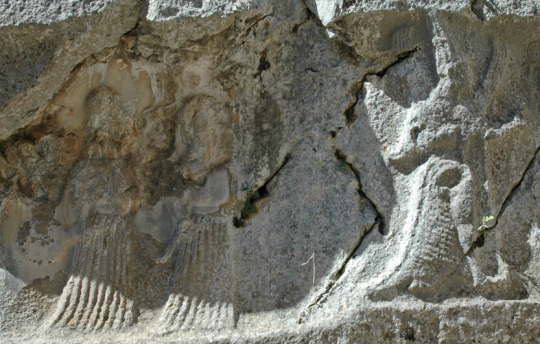
Masculine Shaushka (right) accompanied by Ninatta and Kulitta (wikimedia commons)

A restoration of the procession of goddesses, including feminine Shaushka (wikimedia commons)
A number of epithets applied to Shaushka were similarly explicitly feminine, for instance Hurrian “lady of Nineveh” (allai Ninuwawa) and Hittite “woman of that which is repeatedly spoken” (taršikantaš MUNUS-aš), implicity something like “woman of incantations” (Ištar of Nineveh…, p. 5); magic was apparently understood as a particular competence of this deity (Ištar of Nineveh…, p. 6). There is even a singular case of an incantation being explicitly attributed to Shaushka (Ištar in Ḫatti…, p. 98).
Literary texts, chiefly myths from the so-called Kumarbi cycle, generally portray Shaushka as feminine too, and more as a love deity (to be precise, as something along the lines of a heroic equivalent of a femme fatale) rather than as a warlike one (Ištar in Ḫatti…, p. 85). Mary R. Bachvarova tentatively suggests that a reference to possibly masculine Shaushka might be present in the first of its parts, Song of Going Forth (also known as Song of Kumarbi), which mentions a deity of uncertain gender designated by the logogram KA.ZAL, “powerful”, which she argues has the same meaning as Shaushka’s name (Wisdom of Former…; p. 95 for the text itself, p. 106 for commentary). However, I’m not aware of any subsequent studies adopting this view.
Regardless of the contents of the literary texts available to us presently, Shaushka is explicitly counted among male deities in CTH 712. The enumeration in this ritual text also includes the “femininity and masculinity” of this deity. The male form of Pinikir is there too, though without a separate entry dedicated to any of his attributes or characteristics (Ištar in Ḫatti…, p. 219). Another example might be less direct: two descriptions of depictions of Shaushka use the terms “helmeted” (kurutawant), which referred to headwear worn by gods, as opposed to “veiled” (ḫupitawant), which referred to the typical headwear of goddesses. This lines up with the relief of masculine Shaushka from Yazilikaya (Ištar in Ḫatti…, p. 300).
A detail I haven’t seen brought up in any discussion of Shaushka’s gender which I personally think might be relevant to this topic is that their name occurs as a theophoric element both in feminine and masculine Hurrian theophoric names, which is otherwise entirely unheard of. Hurrians evidently were more rigid than Mesopotamians when it comes to theophoric elements in given names, as goddesses occur only in names of women and gods in names of men (Gernot Wilhelm, Name, Namengebung D. Bei den Hurritern, p. 125).
Interestingly, Hittite sources pertaining to Shaushka offer a parallel to the “genderbending” curse formulas as well (My Men Have…, p. 363-364; note they are actually slightly earlier than the Assyrian examples). In a few cases, including a prayer and military oaths, this deity is implored to deprive foreign adversaries of the Hittite empire of their masculinity and courage, to take away their weapons, and to make them dress like women (Ištar in Ḫatti…, p. 90).
How did this aspect of Shaushka’s character develop? I’d assume that in contrast with Ninsianna and Pinikir, the influence of astronomical ideas about Venus can probably be ruled out. Beckman stresses that at least in Anatolian context Shaushka was evidently not an astral deity (Ištar of Nineveh…, p. 7). Timothy D. Leonard argues that the wings, which only the male form possesses, likely reflect a celestial role, but he doesn’t explore the point further (Ištar in Ḫatti…, p. 211). However, he notes that only Pinikir is explicitly identified with Venus in Hurro-Hittite sources, and presumably fulfilled the role of personification of this astral body alone (p. 225).
Leonard argues that it cannot be established with certainty whether Shaushka was perceived as capable of taking both male and female forms, as existing simultaneously as a male and female deity (with two bodies, presumably), or if they should be regarded as androgynous. However, he notes that there is no evidence for the recognition of any sort of nonbinary identity in known Hittite sources - so at least implicitly, he assumes the gender of both of the forms would need to be binary (Ištar in Ḫatti…, p. 298).
It needs to be noted that the validity of applying the label “androgynous” to Shaushka has already been questioned all the way back in 1980(!) - in the first detailed study of Shaushka’s character and cult ever published, Ilse Wegner argued that in both visual arts and literary texts they are presented either as feminine or masculine, but never is their gender ambiguous (Gestalt und Kult der Ištar-Šawuška in Kleinasien, p. 47). Frans Wiggermann argues that KAR 307, which I already discussed and which describes a single figure with both masculine and feminine traits, might be related to depictions of Shaushka (Mischwesen A…, p. 237; thus I suppose the text would deal with an Ishtar, not with Inanna slash Ishtar herself) but this would quit obviously at best constitute a late exception which could be attributed to very vague familiarity with the deity.
In addition to the options discussed by Leonard, a further interpretation present in scholarship is possibility is that Shaushka might have been seen primarily as a goddess, but performed a male role in specific context, to be precise when portrayed as a warlike deity (Ištar in Ḫatti…, p. 301) - in other words, that we are dealing with a similar phenomenon as in the case of Inanna. For instance, Wegner assumed Shaushka was essentially female, and the masculine portrayals merely reflect adoption of masculine-coded character traits and attributes as opposed to actual transformation into a male figure (p. 47-48). Gary Beckman similarly suggests that Shaushka was a goddess, and that the male form, which he likewise considers to be a military aspect, was interpreted as crossdressing, as opposed to an actual shift in gender (Shawushka, p. 1). Leonard accepts the possibility that the male form might reflect the fact that warfare was seen as an exclusively masculine pursuit in Anatolia, though since there are multiple sources where goddesses whose gender never shifted in any way appear on the battlefield he stresses it’s not impossible such gender norms did not necessarily apply to deities (Ištar in Ḫatti, p. 299-300).
Out of all the possible interpretations I personally find the possibility that Shaushka was imagined to shift between a male and a female deity to be the most convincing - in other words, that they were viewed as genderfluid, similarly to Ninsianna, though almost definitely for different, presently impossible to determine, reasons. However, since the matter is far from settled, I opted to generally use neutral forms across this section of the article - I hope this doesn’t make it too confusing. Can any of the information pertaining to Shaushka be applied to Inanna as well? I don’t really think so. For starters, no source goes out of its way to depict a feminine and a masculine form of Inanna in the same location, so I would argue that it is significant this is something attested for her counterpart - a sign that the latter’s masculine identity was more pronounced. Note that this is only my personal impression, though, and it might not fully hold to academic scrutiny, not to mention that the emergence of new sources might invalidate it.
Beyond Inanna: Shaushka’s other connections
While I focused on the connection between Shaushka and Inanna, it’s necessary to point out that the former was more than just a “foreign counterpart”. As a deity worshiped for well over a millennium, they amassed their own complex network of deities - often completely distinct from Inanna. For instance, it’s hard to find a parallel to Shaushka’s position as the sibling (and, in myths, main ally) of the head of the Hurrian pantheon, Teshub (not least because he represented a somewhat different model of a head god than Mesopotamian Enlil and Anu). However, to do this matter justice I’d basically need a separate article. Due to the scope of this treatment of Shaushka, I will limit myself only to a small number of figures they were associated with - either because they have something to do with their gender, or because they are additionally in one way or another connected to Inanna.
In Hittite context, Shaushka came to be closely associated with an Anatolian deity, Anzili (Ištar in Ḫatti…, p. 112). Since the latter’s character is poorly known (Ištar in Ḫatti…, p. 113), the reasoning behind the equivalence between them is opaque (Ištar in Ḫatti…, p. 119). Timothy D. Leonard tentatively proposes that Anzili’s name might be grammatically masculine and that it originally designated a god who later came to be seen as a goddess (as reflected in available sources), or that similarly as in the case of Shaushka both a male and a female form could be attributed to them (Ištar in Ḫatti…, p. 117).
Untangling this problem is complicated further by the fact that Anzili’s name is used simply as a Hittite translation of Shaushka in both ritual and literary texts in which the deity of Nineveh is undeniably meant, down to being explicitly referred to with titles pertaining to this city - where Anzili obviously wasn’t actually worshiped (Ištar in Ḫatti…, p.120-121). Through the association with Shaushka, Anzili’s name even got to be used to translate the name of their Mesopotamian counterpart a few times - the Hittite translation of King of Battle, the most famous epic about Sargon of Akkad, refers to his divine backer as… “Anzili of Akkad” (Ištar in Ḫatti…, p. 125). Ultimately the translation was not entirely consistent, though, and texts written in Hittite where Shaushka’s name is nonetheless rendered phonetically, leaving no possibility that it was translated as Anzili, are also known (Ištar in Ḫatti…, p. 126).
Next to Inanna and Anzili, the deities probably the most commonly associated with Shaushka were their handmaidens Ninatta and Kulitta (Ištar of Nineveh…, p. 6). They could be portrayed as divine musicians (Gestalt und Kult…, p. 78), but also as warlike deities (John MacGinnis, The Gods of Arbail, p. 109). Ilse Wegner went as far as suggesting the phrase “right weapon of Shaushka” was an apposition of the pair, though that’s obviously speculative (Gestalt und Kult…, p. 79).
Further information about their role is provided in a hymn to Shaushka (CTH 717). They are grouped in it with two other handmaidens, Šintal-irti (“seven-tongues”) and Ḫamra-zunna. The four of them are supposed to look after households which Shaushka views favorably, so that their inhabitants can live in harmony. Meanwhile, four other handmaidens, Ali, Ḫalzari, Taruwi and Šinanda-dukarni, are entrusted with making people in households which Shaushka resents quarrel with each other (Ištar in Ḫatti…, p. 120-122). It has been argued that this reflects the two aspects of Shaushka’s character - as a love deity in the case of the first four handmaidens, and as a warlike one in the case of the second group (Ištar in Ḫatti…, p. 123) - but I am skeptical if this can be easily reconciled with the fact Ninatta and Kulitta appear with them no matter which side of them is in the spotlight.
Ninatta and Kulitta also represent probably the strongest case of Shaushka leaving a mark on their Mesopotamian counterpart. In the Neo-Assyrian period, they appear as members of the entourage of the latter not only in Nineveh, but also in Arbela and Assur under “Akkadianized” forms of their names, Ninittu and Kulittu (The Gods of Arbail, p. 109)
While Inanna had an extensive court - something that for mysterious reasons is not acknowledged online or even in publications aimed at general audiences (to use a recent example - even an a-list example like Nanaya comes up less times in Louise Pryke’s Ishtar than Buffy the Vampire Slayer, who, as far as I am aware, is not attested in any cuneiform texts) - I’m not aware of any instance of Ninatta and Kulitta being explicitly identified as counterparts of any of its members, though. Perhaps the fact that some of the cities in which they are attested were originally Hurrian has something to do with it - they weren’t introduced there as new additions, it was the Mesopotamian goddess who was superimposed over their original superior (The Gods of Arbail, p. 112).
Madonna-whore complex and beyond: (the modern reception of) Inanna as a love deity
After the brief detour focused on Shaushka, it is time to go back to Inanna - specifically to the most major aspect of her character I largely left out before, her association with love and all that entails.
As I already said, the oldest available texts affirming this was one of her prerogatives are younger than these linking her with war, let alone these hinting at her astral role. Regardless of when this aspect of her character first developed, it took until the Ur III period for it to take the center stage (Inanna and Ishtar…, p. 338). Simultaneously, it is by far the most well known today, to the point you often get the impression people barely know there’s more to her. Tonia M. Sharlach notes that even in scholarship there is discussion over whether this aspect of her character isn’t perhaps overestimated to a degree (An Ox of One’s Own. Royal Wives and Religion at the Court of the Third Dynasty of Ur, p. 268).
At least when it comes to the spread of this misconception online, one is tempted to ask to which degree pretending this is the only thing about Inanna that matters amounts to the need to present her as some sort of demo version of Aphrodite, with limited, if any, concern for Mesopotamia.
None of these phenomena is why I kept it for last, though - even if I do agree that viewing Inanna simply as a “love goddess” is misguided at best. My decision simply reflects the fact that the relevant sources portray Inanna probably at her least gender nonconforming . As argued by Bendt Alster, in some cases in love poetry it would essentially be possible to substitute her and Dumuzi for an average young human couple without the need to make any adjustments (Sumerian Love Songs, p. 78). Ultimately, these works reflect fairly normative ideas of courtship, romance and sex, though with a clear female focus (Frans Wiggermann, Sexuality A. In Mesopotamia, p. 412). The portrayal of love and eroticism in them has been described as “playful”, in contrast with the more blunt genres like potency incantations, or even with portrayal of sex in myths like Enki and Ninhursag (Jerrold S. Cooper, Gendered Sexuality in Sumerian Love Poetry, p. 92-94). Many of them are honestly an enjoyable read, as long as you are willing to engage with heavy use of assorted metaphors in descriptions of sex (date syrup, lettuce and agricultural activities are particularly abundant). Here is a fairly representative example:

The Song of the Lettuce (ETCSL)
There isn’t really much to say beyond that - they’re a fascinating topic in their own right, but they are largely irrelevant for the matter this article investigates.
Frans Wiggermann, an author whose work I generally value highly, made the peculiar argument that erotic poetry in which Inanna is the more active side and her goal is sexual gratification might reflect attribution of masculine traits to her and proceeded to argue every depiction of sex where the woman tops is ought to be related to this phenomenon (Sexuality A…, p. 417-418). He simultaneously raises an interesting point that these representations of Inanna might have been supposed to justify sex without the aim of reproduction. It is unclear to me how it would “allow minorities a place under the sun”, though (p. 418), as the sex scenes in relevant compositions are invariably straight.
While I am unsure about some aspects of Wiggermann’s argument, I should stress that I think it was made in good faith. Sadly this can’t be said about much of the other scholarship pertaining to Inanna and sexuality, and especially the intersection of the topic of sexuality and gender. This matter has been investigated in depth by Zainab Bahrani in the early 2000s already. She argues that publications which overestimate the ambiguity of Inanna’s gender (which typically employ hardly applicable labels like “hermaphrodite”; she singles out Rivkah Harris’ Inanna-Ishtar as Paradox and a Coincidence of Opposites and Brigitte Groenberg’s Die sumerisch-akkadische Inanna/Ištar: Hermaphroditos? as relatively recent examples), in particular while emphasizing her erotic character, are essentially a leftover a fear of nefarious seductresses common in popular culture of fin-de-siècle Europe, for example in symbolist paintings (Women of Babylon…, p. 146).

Jen Delville's The Idol of Perversity, a fairly standard example of the sort of symbolist painting Bahrani meant, a representation of the fear of "unquenched bestial desires of a woman" (wikimedia commons)
I think it’s also a valid point that traits like assertiveness or a quick temper could very well be assigned to a femme fatale, and are not necessarily an indication of any ambiguity of gender (Women of Babylon…, p. 144), though I don’t think every aspect of Inanna’s characters needs to be subsumed under the erotic, and recent publications focused on her military role and its intersection with gender are much more nuanced, as you could see for yourself earlier.
Bahrani also highlights that publications she criticizes - both historical and modern - treat transsexuality, crossdressing and various adjacent phenomena and (male) homosexuality as basically one and the same (Women of Babylon…, p. 145; I will come back to this). However, I feel she falls into this trap herself to a small degree when it comes to women, as she appears to link the dubious Inanna scholarship overestimating the ambiguity of her gender and the phenomenon of various femme fatale figures being portrayed as bisexual for voyeuristic purposes, and to Orientalist art at the very least implying lesbian activities (Women of Babylon…, p. 146). I am not aware of any actual publication dealing with Inanna or relevant phenomena (of any quality) which would go into this direction, though.
I also disagree with treating Inanna as unique compared to other goddesses just because she is not primarily portrayed as a wife or mother (Women of Babylon…, p. 149) - the median Mesopotamian goddess was a personification of a profession or the interests of a city or both, arguably; major members of the pantheon like Nanshe, Nisaba, Ninmug, Nungal or numerous medicine goddesses were hardly defined by either of these two roles, even if they could be, indeed, portrayed as wives or mothers in a capacity Inanna was not.
Most importantly, I disagree with invoking Freud and his disciples (positively, for clarity) to bolster arguments (Women of Babylon…, p. 153-154).
Still, I do think the core concerns raised by Bahrani are more than sound. The next section will sadly make that painfully clear.
Sexualization of lamenting
The validity of some of Bahrani’s criticism is pretty evident just based on the survey of past literature on the matter of the assinnu (The Misconstructed Role…, p. 83-84), a type of religious specialist or performer who you already met earlier in the subsection of this article dedicated to military curses. It would appear that the authors most keen on far reaching speculations about their gender identity and sexuality are probably some of the least qualified to deal with this matter, and lo and lo and behold, typically blur together being gay, nonbinary and any form of gender nonconformity.
Furthermore, even though texts from Mari explicitly link the assinnu with Annunitu (The Misconstructed Role…, p. 94) - the single most straightforwardly warlike Inanna-ish deity of them all, whose very name, “the skirmisher”, refers to combat - a peculiar obsession with rendering their role into something innately sexual (or rather lascivious) just because of their association with Inanna, appears to be a distinct trend. It intersects with the former issue; after all, it is known that anything but being a cis straight person who is a paragon of gender conformity is innately inappropriately (or even “abnormally”, as one of the past evaluations cited by Zsolnay critically put it) sexual.
For what it’s worth, there is some evidence that the assinnu were men who - at least in certain situations - crossdressed and played lyres (The Misconstructed Role…, p. 86). In an Old Babylonian hymn I’ve already mentioned, this is said to take place during a festival which also involved female performers who for this occasion dressed up in a masculine way and carried weapons, who are not described with any specific technical term (The Man is Like…, p. 6). Given the context of this mention, I feel the jury's out on whether this was universal, or merely a specific local festival, especially in the light of other evidence for the activities of the assinnu, though. The participation in a celebration which involved crossdressing could explain why late lexical lists - first examples only come from the Neo-Assyrian period, some 1000 years after the Mariote and Old Babylonian attestations - sometimes offer UR.SAL as the logographic writing of assinnu. This combination of signs can be interpreted in different ways - some probably can be ruled out since they refer to female animals (canines and big cats), not to people; this led to the common interpretation as “feminine man” or “woman-man” based on other sign values. Zsolnay disagrees with it, and tentatively proposes something like “servant of women” (The Misconstructed Role…, p. 85)., though this might be an overabundance of skepticism.
However, Zsolnay’s position might not be entirely unwarranted. She correctly points out lexical lists are not necessarily reliable when it comes to synonyms of technical terms, such as religious titles (The Misconstructed Role…, p. 86). Furthermore, the assinnu seemingly were famous for performing a song titled “Battle is my game, warfare is my game” (mēlilī qablu mēlilī tāḫāzu; presumably purposely a nod to terms often used to describe Inanna’s warlike characteristics). They also danced the “whirl dance” (gūštu) - which likely also had belligerent connotations, and which quite importantly is the main topic of the poem Agušaya, which entirely focuses on Inanna as a warlike deity (The Misconstructed Role…, p. 93). Yet more important is the fact that UR.SAL is not the only combination of logograms which could be used to render the term assinnu. The other option, SAG.UR.SAĜ, literally means “foremost hero” - in other words, it does appears to point at some sort of “warlike” or, to be more precise, “heroic” role (The Misconstructed Role…, p. 85). Zsolnay accordingly concludes that the ordinary role of the assinnu was most likely that of an exaggerated “heroic strongman” performing war dances, and that with time an association between these specialists and festivals associated with the military aspect of Inanna (and similar deities like Annunitum) developed due to obvious similarities (The Misconstructed Role…, p. 98).
Nonetheless, just due to the association with Inanna combined with possibly vaguely gender nonconforming behavior (I will not attempt to evaluate whether it was a staple of their activities or only one of the celebrations they took part with), they came to be described in questionable scholarship as “temple prostitutes” (not an actually attested insitution, though it is evident we are dealing with a multi level conflation of crossdressing, being gay or trans, and sex work based on quotes from previous studies provided) whose very existence simultaneously must have terrified the general populace (The Misconstructed Role…, p. 85).
I feel obliged to point out in a footnote Zsolnay states that after finishing her article she was informed by a reviewer similar conclusions about assinnu have been independently reached by Julia Assante in Bad Girls and Kinky Boys? The Modern Prostituting of Ishtar, Her Clergy and Her Cults. Sadly, while I am quite sympathetic to the latter author’s valiant struggle against the myth of “sacred prostitution” and related problems, her methodology is much more flawed than Zsolnay’s, and at times it feels like she herself falls into some of the pitfalls she correctly points out in other studies. I also feel obliged to warn you that for reasons uncertain to me, Assante at some point in the 2010s abandoned academic work and became a medium. Therefore, I would engage with her publications cautiously, to put it very lightly.
There’s at least one point Assante raises which warrants further consideration, though (even if she phrases it very differently than I would). She notes it is peculiar that any individuals whose gender might have been perceived as non-normative or ambiguous, or whose gender is unclear, are automatically presumed to be AMAB, and the possibility that women might have been gender non-conforming, or that people whose gender identity might have differed from Mesopotamian norms were AFAB, is not considered seriously. As an example, she points out that a passage according to which an enigmatic cultic official, the pilipili, received a weapon “as if she were male” sparked little, if any discussion (Bad Girls…, p. 36). This is definitely agreeable, and if nothing else a good start for further inquiries, considering no detailed studies of the pilipili alone have been conducted, as far as I am aware.
It might be worth noting that in the satirical Old Babylonian literary text The Old Man and the Young Girl the second of the eponymous character tricks her way into temporarily reversing gender norms through a royal court verdict, which prompts her to encourage other women to “behave like the pilipili” to celebrate her victory (Jana Matuszak, A Complete Reconstruction, New Edition and Interpretation of the Sumerian Morality Tale ‘The Old Man and the Young Girl’, p.192-193). While more evidence would be necessary to make a genuinely strong case, the possibility that the pilipili were women perceived as gender non-conforming does seem compelling to me on this basis - so, I suppose, credit to Assante in that regard, even if her treatment of the matter leaves a bit to be desired. It’s worth noting a similar proposal about the identity of the pilipili has recently been advanced by Sophus Helle based on the same passage Assante cited (Enheduana. The Complete Poems of the World's First Author, p. 158).
On a further related note, as a pure curiosity it’s worth mentioning that a single lexical list, Malku, lists the feminine form of assinnu - assinnatum - who never sparked the sort of discussion her counterpart did. It should be noted that this label is explained in this context as a synonym of ugbabtum, a fairly widespread type of priestesses (attestations are spread virtually everywhere from Terqa to Susa) involved in the cults of various deities (The Misconstructed Role…, p. 86). As far as I am aware, this is an isolated example, so for the time being it’s impossible to determine if assinnatum ever designated a distinct class of performers or cultic personnel or if it was a scribal invention. I’ll refrain from any speculation about whether it might have anything to do with the women who appear alongside assinnu in the Old Babylonian hymn discussed earlier.
To go back to the assinnu themselves one last time, a further thing to note is that sometimes far reaching dubious conclusions are drawn based not even on information pertaining to these performers themselves, but rather the gala and an enigmatic class of cultic officials presumably involved in mourning, the kurgarrû. However, while the latter two occur together quite often in literary texts (recall that the two clay beings in Inanna’s Descent bear the names Kurgarra - an obvious variant of kurgarrû - and Galatura, ie. “little gala”; however, note as well that gala also commonly occur alongside ašipu), there is very little evidence for any actual close association between them and assinnu - they only occur side by side in a single literary text, the lament Uru-Amirabi (The Misconstructed Role…, p. 91).
The gala (Akkadian kalû; not to be confused with galla, either literally a “gendarme” or town guard, or a type of demon fulfilling an analogous role in the underworld) themselves warrant some further discussion, as they are probably the most egregious example of the phenomenon discussed in this section of the article.
The primary role of the gala was performing various types of hymns, prayers and laments in emesal, a dialect of Sumerian (Paul Delnero, How To Do Things With Tears. Ritual Lamenting in Ancient Mesopotamia, p. 41). Through the third and second millennia BCE, gala most commonly occur alongside temple singers (nāru), for reasons which should be self explanatory, while in the first millennium BCE - alongside āšipu, a type of exorcist, which reflected the involvement of both groups in scholarship (Uri Gabbay, The kalû Priest and kalûtu Literature in Assyria, p. 116).
The gender identity of the gala is a subject of much debate. It might have been unique to them (in other words, they were nonbinary, with gala being both a professional designation and gender identity) or alternatively they might have been men who engaged in broadly speaking gender nonconforming behavior (How To Do…, p. 109). I am not going to attempt to convince you one option or the other is more plausible, I personally don’t think the matter will ever be possible to fully settle unless texts written by gala themselves going in depth into how they perceived themselves ever emerge. Obviously, we also have to take into account what exactly being a gala entailed varied between time periods and locations.
The only thing that can be said for sure is that the gala were not regarded as women. This seems to be an entirely online misconception, though one with an enormous reach - a post making similar claims garnered some 40k notes on this site recently. Said post also stated that they underwent “gender affirming surgery”; it needs to be noted that the status of the gala - or any other type of clergy - was in fact not attributed to any medical procedure (and I don’t think Magnus Hirschfeld, who pioneered gender affirming surgery and deserves more credit than he gets for it, lived in Early Dynastic Mesopotamia…). Obviously, this is not a denial of the possibility the gala weren’t cis (to put in in modern terms) - but it seems beyond credulous to both claim their identity depended on a medical procedure alone, and to project a fairly recent accomplishment for which a genuinely heroic maverick should be credited into incredibly distant past. I don’t think we need a trans version of “ancient matriarchy” mirages, personally.
However, ultimately the main misconception about gala is that they were “priests of Inanna” - and various mortifying hot takes emerge specifically from that. Especially online, more or less haphazard attempts are made to prove that, despite the plentiful evidence for what being a gala entailed, their role - and the roles of any even just tangentially related religious personnel - was innately sexual, since it was tied to Inanna (we have such choice tidbits as “males who engage in transgendered or prostitute behavior”, courtesy of Patrick Taylor, The Gala and the Gallos, p. 176; unclear to me how these labels are in any shape or form interchangeable).
To put it bluntly: it seems like to some the fact the gala might have been, broadly speaking, lgbt (or just gender non-conforming) is in itself something sexual, much like the possibly gender nonconforming performance of the assinnu.
What differentiates this view of the gala from similar faulty opinions about the assinnu is that I think at least online the intent often isn’t malicious - it is not wrong to hope someone in the past was similar (as I understand, the underlying assumption behind many misguided post is that the gala were trans women). However, sadly the underlying motivation of the authors whose takes end up laundered to teenagers online this way is ultimately an example of the same phenomenon which, in a more extreme form, leads to various suspicious groups calling for removal of the tamest possible literature for teenagers from libraries because a gay or trans character appears.
A further problem is that while the assinnu indeed occur chiefly in association with Inanna, the gala were not innately associated with her (and especially not with her sexual side) - referring to them as “priests of Inanna” is a misconception at best, and outright malevolent at worst (in bad faith cases, the logic follows what Bahrani described pretty closely). They were actually present in the cults of numerous deities, most of whom were paragons of gender conformity and had no sexual aspect to speak of - in other words, whatever the identity of the gala was, it was disconnected from the identity of the deity they performed for. Every single major temple dedicated to a city deity had a “chief gala” among its staff. Such an official oversaw the activities of other gala employed by it, but also took part in day to day economic activities of the temple, like managing prebends (How To Do…, p. 110). To go through all of the available evidence would take too much space, so I will only list a handful of particularly notable examples.
There was a “chief gala” among the staff of Ninurta’s main temple Eshumesha in Nippur, as attested in a list of provisions where this official appears next to a “chief singer” (Wolfgang Heimpel, Balang Gods, p. 583). In Old Babylonian Kish another “chief gala” was the second most important religious official in service of Zababa, with only the temple administrator ranking higher (Walther Sallaberger, Zababa, p. 165). A further “chief gala” resided in the temple of Sin in Harran, as attested in sources from the Neo-Assyrian period; the holders of this office were tasked with sending astronomical reports to the kings of Assyria (Steven W. Holloway, Aššur is king! Aššur is king! Religion in the exercise of power in the Neo-Assyrian Empire, p. 409). A “chief gala”, as well as a number of regular gala, were also part of the staff of the temple of Nanshe in NINA (reading uncertain; Tell Zurghul) in the Early Dynastic state of Lagash (Gebhard J. Selz, Untersuchungen zur Götterwelt des altsumerischen Stadtstaates von Lagaš, p. 205-206).
It’s important to note that the arts of the gala and the knowledge transferred among members of this profession - kalûtu - were associated with Ea, not with Inanna; the closest parallel are, once again, the arts of the āšipu (The kalû Priest…, p. 116). However, it would be disingenuous to call them “clergy of Ea” - I’m just highlighting they had no specific connection with Inanna. Stressing the lack of any unique degree of connection between her and the gala is not supposed to be an argument against inquiries into their gender identity, either - though I do advise to be cautious which authors are consulted.
Maternal obsessions: do deities even follow gender roles?
While I dedicated a lot of space to warnings about questionable motivation behind some arguments pertaining to the gender of Inanna and especially clergy with varying degrees of association with her, it needs to be stressed that there’s a need to be cautious about the exact opposite attitudes too sometimes. While skepticism is generally a virtue in scholarship, it is hard to deny that some of the opposition to inquiries into Inanna’s gender and related matters also has highly questionable motivations behind it.
For instance, my reservations towards Julia Assante’s article discussed earlier come from the fact that at least some of her criticism is rooted not in valid reasoning, but in what appears to be a degree of homophobia - for instance, part of her opposition to interpreting cultic officials like the assinnu or gala as gay men (for which the evidence is indeed hardly sufficient - we have evidence for crossdressing in one case, and for either gender nonconformity or a unique gender identity in the other) stems from her conviction that this is an example of “abnormal male sexuality” (Bad Girls…, p. 37).
Interestingly this is a selective case of homophobia, though, since she simultaneously voices a perfectly valid complaint that earlier scholarship has “not allowed discussion on lesbianism other than to dismiss it” (p. 36; it needs to be noted that in contrast with gay men, direct evidence for lesbians is lacking altogether in cuneiform - see Sexuality A…, p. 414 for reference to a MLM love incantation and absence of a WLW equivalent - but you’d at least expect some serious inquiry into Ninshubur’s portrayal in literary texts by now). Some examples are even more blunt. For instance, Wolfhang Heimpel, after concluding that references to “bearded” Inanna reflect the perception of the planet Venus as opposed to the deity (which is not too dissimilar from the interpretation I highlighted as plausible earlier) reassures the reader that Inanna was therefore not an “androgynous monster” (A Catalog of Near Eastern Venus Deities, p. 15) - I am somewhat puzzled what exactly would be “monstrous” about facial hair. It’s hard to escape the conclusion that in contrast with the newer study of the same passages which I discussed in detail and have no objections to, it’s not the weakness of the evidence that bothers the author, but the slightest possibility of androgyny.
Not everyone is so direct, though. There are also more insidious cases - and these invariably focus on Inanna herself, as opposed to any religious officials. What I’m talking about are sources which refer to Inanna as a “mother” or “fertility” goddess or some nondescript “divine feminine” entity entirely detached from historical context. As a result Inanna is essentially forced into an incredibly rigid feminine role she never actually fulfilled. I won’t dwell upon the abstract maternal obsession itself much here. I already wrote a separate article a few years ago about its impact, exemplified by the recent portrayal of Inanna as a grotesque pregnancy monster in a certain videogame (this is not an exaggeration) and I think that was enough. It will suffice to say that these visions belong not in Mesopotamia at the dawn of recorded history, but rather in the most feverish depths of Victorian imagination (I won’t explore this topic here; Cynthia Eller’s publications are a good start if you are interested, though). Interestingly, simultaneously sources of this sort basically never investigate Mesopotamian texts which actually focus on motherhood - which is a shame, because compositions such as Ninisina A are filled with genuine warmth. However, they don’t deal with some sort of overwhelming Frazerian ur-mother reduced to bare biological essentials.
To go back to the main topic of this section, the true crown jewel of the discussed subgenre of Inanna literature has to be this paragraph courtesy of Tzvi Abusch (Ishtar in Dictionary of Deities and Demons in the Bible, p. 453):
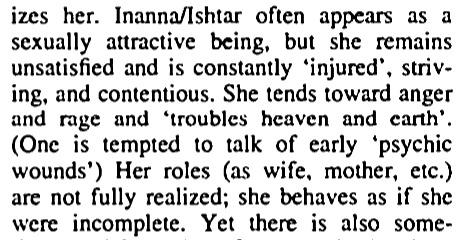
One is tempted to ask why Abusch argues Inanna is “incomplete” or exhibits “psychic wounds” due to her character not revolving around being a wife or mother. How about her roles as a war deity, love deity, personified astral body or representation of political interest of one city or another? Roles which are, quite obviously, fully realized? As a war deity, she was believed to assist kings, deprive their enemies of the ability to fight, and to confront various supernatural adversaries like rebellious mountains; as a love deity, she was invoked through love incantations and acted as the archetypal lover in erotic poetry; as Venus, she shone in the sky.
Should we also question why, for example Tishpak’s roles as a husband and father are not fully realized considering he primarily plays the role of a warrior and divine sovereign of Eshnunna (the human ruler was merely acting as a governor on his behalf, a fairly unique situation otherwise only attested for two other gods)? Very few male gods actually match the image of masculinity presented in Instruction of Shuruppak as an ideal to strive for - just as very few goddesses fit the image of the ideal wife preserved in proverbs.
This is not the first time this comes up in this article, but while the world of gods, and the character of its individual inhabitants, obviously arose in specific historical context, it was not a perfect mirror of the world of humans and its mores (Do Divine Structures …, p. 105-106). Ilona Zsolnay outright argues that even if some (but not all) of the Mesopotamian deities were at least in part characterized based on normative patterns of behavior tied to them - there are, after all, deities defined at least to a degree by, for example, fatherhood (like Enlil) or marital status (like Aya) - ultimately they were not bound by the same gender norms as humans. Furthermore, religious and political factors, as well as natural phenomena deities could be linked with, influenced their character considerably more (Do Divine Structures …, p. 116).
Granted, it should be noted that Abush is basically writing about an Inanna he made up. As you’ve seen earlier, the first attestations of Inanna already sound fairly similar to her most famous portrayals from later periods. However, he instead argues that the original Inanna lost to time was one of “primitive earth of mother goddesses” and that from the fourth millennium BCE onwards (coincidentally when the first actual attestations of Inanna emerge thanks to the advent of writing) Mesopotamians simply couldn’t grasp her true character (Ishtar, p. 454). The need to portray Inanna as she actually was imagined as some sort of aberration, coupled with a desire to uncover an “original” version which just so happens to conform to an incredibly rigid vision of femininity is quite something. Rarely do you see someone basically recreating the Madonna-whore complex so literally.
Absent parents, ever present children
While as I said I won’t engage in depth with the peculiar obsession with making Inanna into a maternal figure evident in Abusch’s treatment of her, I do feel obliged to cover a related phenomenon: the obsessive focus on the quite rare cases where some minor deities are identified as her children. This is a particularly big problem online, though vintage scholarship and publications aimed at general audiences (even very recent ones) are equally, if not more, guilty of it.
The nominal assignment of largely irrelevant deities as children to Inanna was ultimately inconsequential, and in particular it had nothing to do with her erotic role - or with Dumuzi, for that matter, as he is never identified as their father (Inanna and Ishtar…, p. 339). Pregnancy, childbirth and maternity are not topics dealt with in compositions focused on the two of them (Gendered Sexuality…, p. 95).
Only three deities have ever been described as Inanna’s children in primary sources: Shara, Lulal and Nanaya. In every single case caveats apply.
Shara’s connection to Inanna was geographically limited. It wasn’t a pan-Mesopotamian convention to regard them as related, but rather a local tradition restricted to Zabalam (Goddesses in Context…, p. 202). Julia M. Asher-Greve suggests that it might have originally been little more than a way to give Inanna access to the epithet ama, literally “mother” (but metaphorically, as a divine epithet, something like “venerable woman”; Jeremy Black, Songs of the Goddess Aruru, p. 48), which was however primarily used not to indicate motherhood but rather a position of authority in the pantheon (Goddesses in Context…, p. 140).
It’s also important to note that Inanna of Zabalam didn’t really start as (an) Inanna, since the earliest literary text she appears in, the Early Dynastic Zame Hymns from Abu Salabikh, refers to her with the enigmatic name Nin-UM. Joan Goodnick Westenholz assumed that Nin-UM was the original name of the goddess of Zabalam, with the name Inanna (and many of Inanna’s traits) effectively imposed upon her due to the theological and political influence of nearby Uruk (Goddesses in Context…, p. 42-43). Whether this was the case or not, the two are treated as functionally separate deities in god lists (Goddesses in Context…, p. 79-80).
While this is far from certain, Douglas Frayne proposed that this phenomenon might also be the motif of conflict between Inanna and Gilgamesh, first attested in the standalone poem Gilgamesh and the Bull of Heaven from the Ur III period, and fully developed in the considerably later standard edition of the Epic of Gilgamesh (which might reflect what Paul-Alain Beaulieu described as “anti-Ištar sentiment”; The Pantheon..., p. 108). He assumes that it reflected hostilities between Uruk and Zabalam, with the antagonist actually being Inanna of Zabalam and not Inanna of Uruk (The Struggle for Hegemony in "Early Dynastic II" Sumer, p. 63-64). In any case, the connection with Shara cannot be taken out of context and applied where it is not explicitly mentioned.
The other most frequently cited case, that of Lulal, is even weaker than Shara’s. He is addressed as Inanna’s son exactly once, in a fragmentary hymn published in the 1960s (Anna Glen, Jeremiah Peterson, The Lulal širgida Composition CBS 12590 (HAV 5, pl. 7, VIII), p. 169) - so he has an equally firm claim to being her son as the personified Styx has to being Persephone’s mother. In Inanna’s Descent, the composition most often “enriched” today with forcible assertions of familial bonds between Inanna and miscellaneous side characters, the connection between them is merely “close, but unspecified” (Wilfred G. Lambert, Lulal/Lātarāk, p. 163). Anna Glen and Jeremiah Peterson assume he is an attendant, not a family member, and point out elsewhere (Inanna D, line 32) he is portrayed only as a minor warrior god acting on her behalf (The Lulal širgida…, p. 169). An annotated edition of the Weidner god list equates Lulal with Sin (Klaus Wagensonner, CCP 6.7.A - Weidner’s God List A) which, as it will become clear very soon, creates some issues for claims of widespread acceptance of his status as Inanna’s son.
The third deity sporadically addressed as Inanna’s child was Nanaya. In contrast with both Shara and Lulal, she was actually a major figure in her own right, and her connection with Inanna is attested in various cities and time periods. Ironically enough I don’t think I’ve ever seen her described as her daughter online, though. I suspect the explanation is fairly straightforward: she doesn’t appear in the “canon” of shoddy vintage translations of a small handful of texts on which the online image of Inanna often seems to be built.
However, the fact Nanaya had a firm connection to Inanna doesn’t mean undue importance should be assigned to the cases where they are presented specifically as mother and daughter. Only three sources actually refer to them this way: an inscription of king Lipit-Ishtar, a first millennium recension of an older balag song, and a unique oath formula. Olga Drewnowska-Rymarz assumes the relation described in them might very well be metaphorical (Mesopotamian Goddess Nanāja, p. 30).It would not be hard to find parallels proving this is a distinct possibility: Ninshubur was demonstrably not Inanna’s mother, and yet she addresses her as such as a sign of respect in at least one composition. Ninshubur herself has no known parentage, and yet refers to every high ranking god as “father” in Inanna’s Descent. The examples of using terms of kinship as an indication of respect or closeness are numerous.
Furthermore, multiple genealogies could be assigned to Nanaya. In laments, she is consistently the daughter of Urash, the tutelary god of Dilbat, for instance (Mesopotamian Goddess Nanāja, p. 31). Obviously, the fact that Nanaya could also be at least partially identified with Inanna (though this is a late phenomenon; Goddesses in Context…, p. 131) poses some problems for viewing them as child and parent. In most cases it’s probably best to agree with the description of the relationship between the two as “definite, but unspecified” (Joan Goodnick Westenholz, Nanaya: Lady of Mystery, p. 68).
On a side note which is not directly related to the main topic of this article, it is quite peculiar that preoccupation with Inanna existing as a part of a family never seems to extend to highlighting her connection with her parents. Ironically, the family connections people downplay online are the ones which actually mattered the most theologically.
The tradition making Nanna (Sin) and Ningal Inanna’s parents was by far the most widespread one, and it is reflected in various genres of texts across history (Aino Hätinen, The Moon God Sin in Neo-Assyrian and Neo-Babylonian Times, p. 309-310; Goddesses in Context…, p. 230; The Pantheon…, p. 111; even Abusch’s Ishtar, p. 452). References to this connection are frequent in literary texts, even ones which don’t focus on Inanna, let alone on her family ties. For instance, Ka Hulu-a, which isn’t even a composition dealing with deities on the most part, casually refers to Inanna as “wise daughter of Sin” (dumu galzu Suenna; Jana Matuszak, Don’t Insult Inana! Divine Retribution for Offense against Common Decency in the Light of New Textual Sources, p. 361).
The connection between Inanna and her parents was so strong it could be transferred to other deities by proxy. Both Shaushka (Marie-Claude Trémouille, Šauška, Šawuška A. Philologisch, p. 102) and Pinikir (The Goddess Pirinkir…, p. 27) - not to mention an entire host of major and minor Mesopotamian goddesses, ranging from Annunitum (The Moon God…, p. 313), though Belet-ekallim (Ištar in Ḫatti…, p. 160) to Nanaya (The Moon God…, p. 312) - could be addressed as the moon god’s offspring (or, at the very least, as the offspring of a moon god since at least in Shaushka’s case the name is in all due likeness used as a logogram).
Perhaps even more importantly, the connection between Inanna and her father was also responsible for her well attested association with the number 15, best reflected in the use of this numeral to represent her name from the Old Babylonian period onwards. Since Sin’s number was 30 (a reflection of the number of days in the lunar month), a half of that was deemed a suitable number to represent his daughter by ancient theologians (Wolfgang Röllig, Götterzahlen, p. 499).
Conclusions
I was initially reluctant to cover the topic of the gender of Inanna and related deities in depth, I’m frankly not sure why. It is not my intent to boast, but much of my online activity has consistently revolved around assyriology since 2020 (technically it has been my interest for much longer, but my methodology required refining). I wrote 200+ wiki articles about Mesopotamian deities, including multiple which specifically required dealing with the matter of gender; in contrast with the overwhelming majority of hobbyists I keep up with academic publications.
To go back to the question which originally inspired this article, I don’t think it’s possible to give a straightforward answer. I’d say at least some of the current mainstream Assyriological scholarship (by which I mean roughly from the mid to late 1980s to now) offers a fairly accurate evaluation of what can be said about Inanna’s gender, and about the gender of related figures - Ninsianna, Shaushka, Pinikir etc.; I hope spotlighting sources which can be described this way through the article makes this clear enough. Some specific details are definitely overemphasized (the eerie quest for a beard is the prime example but I’d be lying if I said Wiggermann’s puzzling views on femdom didn’t make me laugh). What is definitely overestimated is to what degree the supposed ambiguity of Inanna’s gender was tied to her sexual aspects. The general lack of any such characteristics among deities even more firmly associated with sexuality than Inanna was - I highlighted it in the case of Nanaya, but it holds equally (if not more) true for Ishara, Gazbaba, Kanisurra, Bizilla, the list goes on - also doesn’t seem to ever be highlighted. While obviously each of them was a deity with own unique character and not just a carbon copy of Inanna (for example, Ishara was associated with weddings in a capacity no other love goddess was, while Nanaya persistently appears in texts dealing with unrequited love or rejection), convergence of traits was a fairly common phenomenon in Mesopotamian religion. For example, numerous couples consisting of a medicine goddess and a war god emerged over the course of the late third and second millennia BCE - so surely it would eventually reemerge in one of these cases?
A further problem is of course the questionable scholarship based on these misconceptions which focuses less on Inanna herself and more on clergy associated with her, or even just vaguely adjacent to her. While a lot has changed since the early 2000s, let alone the 1980s, it is still arguably a major weakness of assyriology as a discipline that often gender, sexual orientation and presentation are often treated as entirely overlapping phenomena. There are numerous authors who write about relevant matters thoughtfully, but this is hardly the rule; especially when assyriology intersects with Bible studies or classics, the problem remains strong (meanwhile, in depth studies of, say, transmission of laments will often be quite cautious; it’s also not as easy as just blaming the age of some researchers and calling it a day).
However, there are also matters related to the gender of Inanna and related deities which definitely receive too little attention. To which degree what we know about Ninsianna can be applied to Inanna? Why the planet Mercury, despite also being regarded as switching between two genders, seemingly never came to be personified the same way as Venus? Why Shaushka and especially Pinikir appear in firmly masculine attire, while Inanna basically never does? All of these questions require further in depth inquiries. Much as I can’t give an unambiguous response to the initial question, I honestly don’t think it’s possible to give a straightforward answer on the matter of Inanna’s gender in the first place. Obviously, it’s impossible to disagree that fundamentally she was primarily a feminine figure. However, it’s also important to remember she essentially took a masculine role in the military context. I still stand by my joke chart from a few months ago:

While as I demonstrated things get much more murky when it comes to outright ambiguity or fluidity of gender, I would not rule it out entirely either, at least in an astral context - though I also doubt it’s fair to speak of anything directly comparable to the cases of Ninsianna, Pinikir or Shaushka.
Perhaps in the end we have to simply accept how Inanna’s character is summarized in an Old Babylonian composition I brought up much earlier:

365 notes
·
View notes
Text
Do Your Research
This phrase is regularly thrown around writeblr and for good reason. It's important to research what you are writing about to know what to include, what can be fudged, and how to depict whatever you're writing. I see "do your research" most thrown around by well-meaning and highly traditionally educated writers. It's solid advice, after all!
But how do you research?
For those writers who don't already have the research skills necessary to write something comfortably already downloaded into your brain, I put this guide together for you.
Where do I even start?
It's a daunting task, research. But the best place to start is with the most basic, stupidest question you can think of. I'm going to talk about something that I already know a lot about: fighting.
When researching fight scenes, a great way to start is to look up what different weapons are. There are tons out there! So ask the stupid questions. What is a sword? What is a gun? How heavy are they?
Google and Wikipedia can help you a lot with these basic-level questions. They aren't great sources for academic articles, but remember, this is fiction. It doesn't need to be perfect, and it doesn't need to be 100% accurate if you don't want it to be. But knowing what is true to life will help you write well. Just like knowing the rules of writing will help you break them.
You may find in your basic research sweep that you have a lot more specific questions. Write them all down. It doesn't matter if they seem obvious. Write them down because they will be useful later.
How To Use Wikipedia Correctly
Wikipedia is a testament to cooperative human knowledge. It's also easy to edit by anonymous users, which means there is a lot of room for inaccuracies and misleading information. Wikipedia is usually pretty good about flagging when a source is needed or when misleading language is obvious, but Wikipedia itself isn't always the most accurate or in-depth source.
Wikipedia is, however, an excellent collection of sources. When I'm researching a subject that I know nothing about, say Norse mythology, a good starting point is the Wikipedia page for Odin. You'll get a little background on Odin's name and Germanic roots, a little backstory on some of the stories, where they appear, and how they are told.
When you read one of the sentences, and it sparks a new question, write the question down, and then click on the superscript number. This will take you directly to the linked source for the stated fact. Click through to that source. Now you have the source where the claim was made. This source may not be a primary source, but a secondary source can still lead you to new discoveries and details that will help you.
By "source-hopping," you can find your way across the internet to different pieces of information more reliably. This information may repeat itself, but you will also find new sources and new avenues of information that can be just as useful.
You mean I don't need a library?
Use your library. Libraries in many parts of the US are free to join, and they have a wealth of information that can be easily downloaded online or accessed via hardcopy books.
You don't, however, need to read every source in the library for any given topic, and you certainly don't need to read the whole book. Academic books are different from fiction. Often their chapters are divided by topic and concept and not by chronological events like a history textbook.
For example, one of my favorite academic books about legislative policy and how policy is passed in the US, by John Kingdon, discusses multiple concepts. These concepts build off one another, but ultimately if you want to know about one specific concept, you can skip to that chapter. This is common in sociological academic books as well.
Going off of my Norse Mythology example in the last section, a book detailing the Norse deities and the stories connected to them will include chapters on each member of the major pantheon. But if I only care about Odin, I can focus on just the chapters about Odin.
Academic Articles and How To Read Them
I know you all know how to read. But learning how to read academic articles and books is a skill unto itself. It's one I didn't quite fully grasp until grad school. Learn to skim. When looking at articles published in journals that include original research, they tend to follow a set structure, and the order in which you read them is not obvious. At all.
Start with the abstract. This is a summary of the paper that will include, in about half a page to a page, the research question, hypothesis, methods/analysis, and conclusions. This abstract will help you determine if the answer to your question is even in this article. Are they asking the right question?
Next, read the research question and hypothesis. The hypothesis will include details about the theory and why the researcher thinks what they think. The literature review will go into much more depth about theories, what other people have done and said, and how that ties into the research of the present article. You don't need to read that just yet.
Skim the methods and analysis section. Look at every data table and graph included and try to find patterns yourself. You don't need to read every word of this section, especially if you don't understand a lot of the words and jargon used. Some key points to consider are: qualitative vs. quantitative data, sample size, confounding factors, and results.
(Some definitions for those of you who are unfamiliar with these terms. Qualitative data is data that cannot be quantified into a number. These are usually stories and anecdotes. Quantitative data is data that can be transferred into a numerical representation. You can't graph qualitative data (directly), but you can graph quantitative data. Sample size is the number of people or things counted (n when used in academic articles). Your sample size can indicate how generalizable your conclusions are. So pay attention. Did the author interview 300 subjects? Or 30? There will be a difference. A confounding factor is a factor that may affect the working theory. An example of a theory would be "increasing LGBTQ resources in a neighborhood would decrease LGBTQ hate crimes in that area." A confounding factor would be "increased reporting of hate crimes in the area." The theory, including the confounding factor, would look like "increasing LGBTQ resources in a neighborhood would increase the reporting of hate crimes in the area, which increases the number of hate crimes measured in that area." The confounding factor changes the outcome because it is a factor not considered in the original theory. When looking at research, see if you can think of anything that may change the theory based on how that factor interacts with the broader concept. Finally, the results are different from the conclusions. The results tell you what the methods spit out. Analysis tells you what the results say, and conclusions tell you what generalizations can be made based on the analysis.)
Next, read the conclusion section. This section will tell you what general conclusions can be made from the information found in the paper. This will tell you what the author found in their research.
Finally, once you've done all that, go back to the literature review section. You don't have to read it necessarily, but reading it will give you an idea of what is in each sourced paper. Take note of the authors and papers sourced in the literature review and repeat the process on those papers. You will get a wide variety of expert opinions on whatever concept or niche you're researching.
Starting to notice a pattern?
My research methods may not necessarily work for everybody, but they are pretty standard practice. You may notice that throughout this guide, I've told you to "source-hop" or follow the sources cited in whatever source you find first. This is incredibly important. You need to know who people are citing when they make claims.
This guide focused on secondary sources for most of the guide. Primary sources are slightly different. Primary sources require understanding the person who created the source, who they were, and their motivations. You also may need to do a little digging into what certain words or phrases meant at the time it was written based on what you are researching. The Prose Edda, for example, is a telling of the Norse mythology stories written by an Icelandic historian in the 13th century. If you do not speak the language spoken in Iceland in 1232, you probably won't be able to read anything close to the original document. In fact, the document was lost for about 300 years. Now there are translations, and those translations are as close to the primary source you can get on Norse Mythology. But even then, you are reading through several veils of translation. Take these things into account when analyzing primary documents.
Research Takes Practice
You won't get everything you need to know immediately. And researching subjects you have no background knowledge of can be daunting, confusing, and frustrating. It takes practice. I learned how to research through higher formal education. But you don't need a degree to write, so why should you need a degree to collect information? I genuinely hope this guide helps others peel away some of the confusion and frustration so they can collect knowledge as voraciously as I do.
– Indy
#writing advice#writing tips#writing resources#writeblr#amwriting#writblr#writers of tumblr#writers on tumblr#writing help#writing guide#how to research#reading research articles#do some research#do your own research#do your research#research for writers#writing research#writing tip#writing reference#writer tips
2K notes
·
View notes
Note
Hi, I love your works!! I was wondering where you find the original, unedited pictures you use for your art? Do you take them yourself or find them online?
Hey there! I get them from many different sources! Whenever I can I use my own, and sometimes my followers send me cool pics to use (or put them up in the Sacrificial Altar channel in my Discord), but I find most of what I use through public domain sources online!
For the online part, I put this little list together with some of the common resources I use! Feel free to share it around and copy it:
For an easier experience, I'll copy the relevant part below:
STOCK SITES
- Unsplash: Usually the best quality out of the free stock sites. They’ll try to sell you a subscription plan but you can ignore that.
- Adobe Stock: Select “Free” on the dropdown menu next to the search bar. The free image selection here is big and high-quality, though they feel more like stock pictures than natural photos. Note: They limit how many pictures you can download per account per day, but you can make several accounts to circumvent this if you use it a lot.
- Texturelabs: lots of free, very high-quality textures!
- Pexels: Similar to Unsplash, but it has more pictures with people. If you need a photo with models, this is usually the best place.
- Pixabay: Widest selection, but worst quality control. Go here if you haven’t found anything in other sites and don’t mind sifting through a bunch of garbage pics and occasional AI images.
PUBLIC DOMAIN SOURCES
- Wikimedia Commons: an enormous selection of CC and public domain pictures. Super useful, especially for the really specific images that you'd expect to find on a Wikipedia article. Always check the copyright conditions! To filter by license, search something and then click on the License dropdown under the search bar. Select “No restrictions” for public domain images.
- Picryl: A repository of public domain sources, ranging from ancient historical books and artifacts to fairly modern pictures. If you're looking for something old/historical, chances are it's here! This website is probably one of the most complicated ones to use, so here are three important tips before you use it:
This site added a paywall that appears after the 3rd page of search results. To remove it, install uBlock Origin, go to the “My Filters” page (clicking on the gear icon after opening the extension), and paste this filter: picryl.com##._9oJ0c2
After searching, use the timeline on the top right to narrow down the result by year.
It won’t let you download the full picture without paying, but it always has a link to the source site below the description. Click on that, then copy-paste the image’s name to find it in the original source. That way you can get it for free, and often in better quality than Picryl offers.
National Archives Catalog, The Library of Congress, NASA, and Europeana have wide selections, but they are included in Picryl so it’s usually better to search there and then download them in the source as mentioned above!
- Flickr Search: a ton of usable pictures with a generally more amateur feel, just remember to filter by license using the “Any license” dropdown menu. When you find an image, make sure to check its specific license (you can find it below the image, on the right side).
- Openverse: The official Creative Commons archive, has many sources! Includes other sites on this list, but has a lot of clutter if you don’t filter.
- iNaturalist: a repository of user-submitted images of animals, plants, and fungi. Look for a genus or species, then navigate to the photo list and filter by license.
MUSEUM COLLECTIONS
- The Met: An amazing selection of artifacts from all over the world, with top quality photographs of most of them (usually with several angles for each). You can filter images by material, location, and era.
- Getty Museum: Another smaller selection of museum pieces, but this one includes old photos as well as artifacts. You can also filter by dates, materials and cultures. Make sure you include the “Open Content” filter to only see public domain things!
- Smithsonian: Big selection of around 5 million museum pieces, with some 3D scans of museum pieces. Most pieces just have a single picture that can sometimes be low quality, but pieces with 3D models sometimes also include a lot of high quality photos from multiple angles. This collection also includes things from museums of natural history, so you can also use it to search for bones and specimens.
- Artvee: public domain classical art. They make you pay to download high-quality images.
If you guys got any others, please let me know and I'll add them to the collection!
199 notes
·
View notes
Text
Shaaloani: The Land of Enchantment Part One

Hello again! It's another lore-adjacent post from me about a niche special interest of mine. This time it's Shaaloani, the American Southwest/Northern Mexico inspired zone in FFXIV's Dawntrail.
I want to disclose a few things right at the start just to temper people's expectations: I will not be definitively ID'ing any of the indigenous-inspired structures or visuals as inspired by any specific tribe. That's not my lane! I'm going to link to things that they remind me of, for sure. But otherwise my hyperfocus is going to be on the physical environment, some animals, and the ceruleum as petroleum industry. It's what I recognize best! And what I know best, truthfully.
"Hon why are you doing this?" A variety of reasons honestly. After DT dropped I saw a lot of folks who did at least one of the following:
Commented on the Old West theme park aspect
Called it "miqo'te Texas"
Generally just called the whole map "Texas"
And if I'm honest... it bugged me! Not because I thought anyone was being malicious about it (it's mostly pop culture saturation I'd suspect), but to me it stung a bit that this zone, which I grew up on the fringe of, was... kind of flattened by a lot of people?
I don't know, the response to me just felt like people assumed they knew everything about it because they'd seen it already in movies or TV or Red Dead Redemption rather than the same open-mindedness about what was presented in places like Urqopacha.
This zone isn't just Texas -- yes there are some bits and pieces here (because it's pulling from the Chihuahuan Desert and the Sonoran Desert), but so much of it reminds me of New Mexico, Mexico, and Arizona. There's some Colorado, Utah, and Nevada there too! And the background story going on there is something that still happens in a lot of those states, by both the government and corporations alike.
That variety deserves to be celebrated! So come learn with me about the inspiration for Shaaloani!
Shaaloani Geography
Shaaloani has three major regions in the zone -- Eshceyaani Wilds, Pyariyoanaan Plain, and Yawtanane Grasslands. To get this out of the way, I'm going to tell you the one that reminds me most of Texas.
Ready?
Lake Taori of the Pyariyoanaan Plain.

It's river-fed, with canyons on both ends of the Niikwerepi. The trees crowding around it are cypress trees, as you can tell by the little nubby off-shoots called knees. To compare, here is a photo of cypress trees along the Frio River:

This is also reminiscent of places along the Rio Grande and Pecos Rivers, two significant water sources in West Texas. I also would not call them bayous! Bayous typically have brackish water, are slow-moving, and are way too far east.
However, it could be partly considered a ciénega -- which according to its wikipedia article:
"Ciénagas are usually associated with seeps or springs, found in canyon headwaters or along margins of streams. Ciénagas often occur because the geomorphology forces water to the surface, over large areas, not merely through a single pool or channel."
As a caveat, ciénegas generally don't have trees around them, but I also know that you can't really drown a cypress and they love sunshine. Regardless -- if you see trees in the desert they are typically growing along a water source. Balmorhea State Park has some cottonwood trees native to the area that are going strong.

Yawtanane Grasslands reads as a mix of the Chihuahuan Desert and the Eastern Plains of Colorado. Both are rather arid and home to a variety of grasses that can thrive in such a climate -- which has historically made both areas home to large cattle industries (whether or not this was ever a good idea is debatable, since cattle are very thirsty animals).
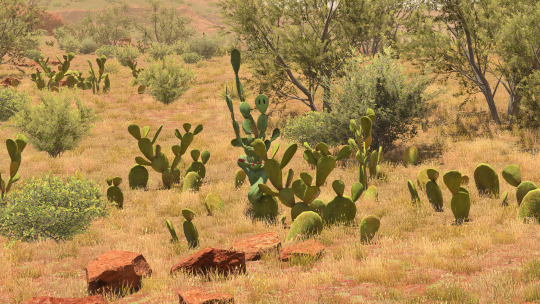
Meanwhile the Eshceyaani Wilds looks similar to the Sonoran Desert -- the red-hued soil and rocks, the abundance of cacti with the scrub brush and some drought-tolerant grasses. Here's a shot of the Sonoran within Saguaro National Park in Arizona:
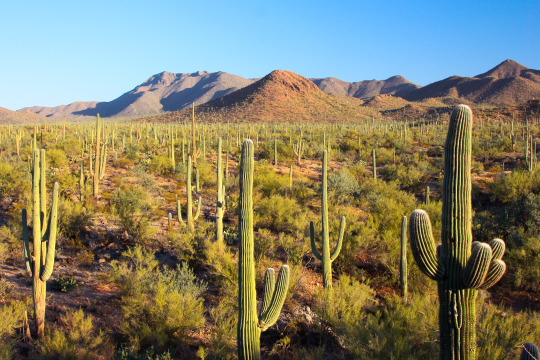
Saguaros also only grow in Arizona in the States! As well as the organ-pipe cactus, which you see in Tender Valley. And prickly pears grow just about anywhere they can get a chance -- as well as barrel cacti, both of which we see in Tender Valley (along with what could be agave!).

You could probably make a case for it being a piñon-juniper scrubland -- everything's very short compared to those cypress trees, including the juniper trees! Piñon-juniper scrubland's found throughout the Southwest. There are also piñon-juniper savannahs and persistent woodlands intermixed in the same places. The difference lay in what plants you find with the piñon pines and junipers.

Visually, aside from the Sonoran Desert, I can also see a lot of New Mexico, like the Ghost Ranch in Rio Arriba:

It matches up with the mountains you can see, and both Yowekwa Canyon and Tender Valley. And of course, Tender Valley is likely a Grand Canyon reference, going by the sheer height of the cliffs. But you could also make a case for Canyonlands National Park in Utah.
There's a shot from Grand View Point Overlook within the park -- the closeness of the canyon walls and the warm earth tones also evoke Tender Valley!

There's also a lot of these sandstone formations in Utah that better fit Shaaloani -- like here in the Valley of the Gods:



Shaaloani Structures
I also at this point want to call attention to one of the two sites with cliff dwellings & adobe structures. We just saw Tender Valley above, which is confirmed to be old Yok Huy structures. But check out these Tonawawta buildings below.

As I stated before, I don't want to state which tribe these two styles remind me of. But I do want to say this again strikes me as another New Mexico and Arizona callback; both the Gila Cliff Dwellings and the Puye Cliff Dwellings are found in two different areas of New Mexico. And the Gíusewa Pueblo, also in New Mexico! Montezuma Castle is found in Arizona, and is pictured below! Look at that rich reddish earth color.

I also want to call attention to the place of worship for the Tonawawta in Yowekwa Canyon:

When I saw it my kneejerk response was to call it an ofrenda. But that's ultimately an incomplete response -- that was just the vibe I felt after seeing them during my life! What it also reminds me of are pictographs and petroglyphs. You find these all over the Southwest (the climate helps preserve them!), but I'm going to link some really great examples. I won't provide images to all though!
Crow Canyon Petroglyphs:
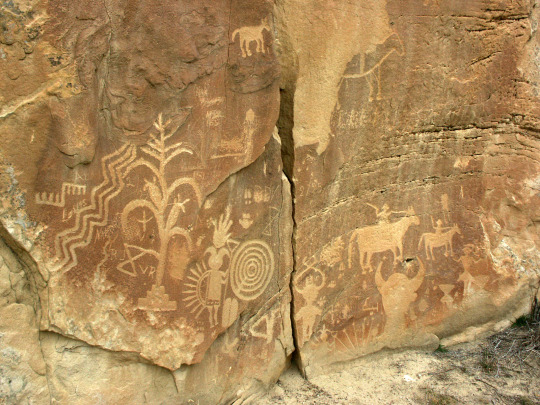
Piedras Madras Canyon at Petroglyph National Monument (New Mexico) Petroglyph Point Trail at Mesa Verde National Park (Colorado) Petroglyph Panel at Canyon Reef National Park (Utah) Nampaweap at Grand Canyon-Parashant National Monument (Arizona) Horseshoe Canyon at Canyonlands National Park (Utah) and the Hueco Tanks State Park (Texas)

In contrast, I don't want to spend a ton of time on the boom town structures in this zone; they are pretty straightforward references to mining towns during the different resource booms (gold, silver, copper, oil).
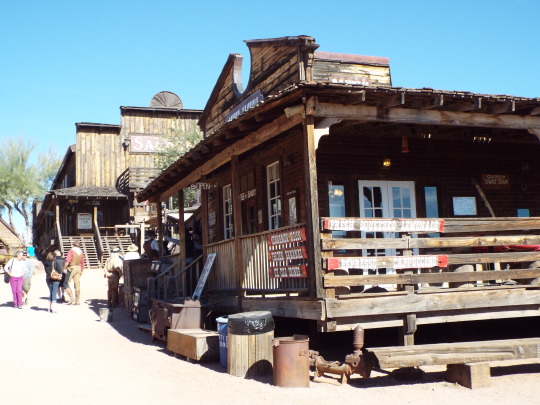
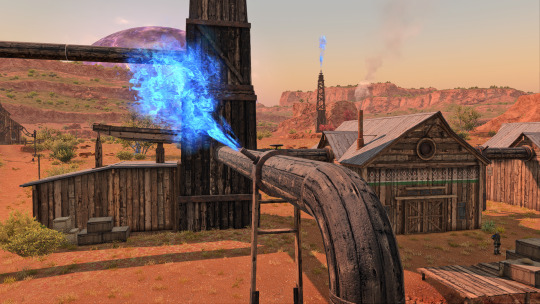
Similar blocky shapes, built out of wood. One thing I noticed as a neat addition are the decorative patterns painted on it -- again, I don't want to presume if there's a specific tribe tied to this. But I do think it's a neat touch and I want to think that's a design choice to convey the underlying theme that this is a zone at odds with advancing technology and wanting to keep hold of important traditions.
I WILL talk about the ceruleum wells and pumping though. Mostly because I'm impressed that they went with structures that so closely resemble early 20th century oil derricks. Those were also predominately made of wood (including the barrels, yikes!). The pump part of what's called a pumpjack were covered in the old days -- the ones we're most used to seeing now are made of metal and are thus left uncovered.



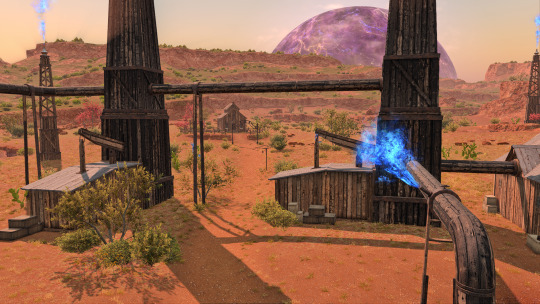
However, as you can see from this century old rig, even the wheel's made of wood:

I don't think ceruleum gushes the same way oil did -- it seems to behave more like natural gas. However, most natural gas pipelines do burn off excess, which can be seen as a little spout of flame atop.
Oil's occupied an awkward spot in the Southwest, and still does. Aside from the heinous crimes committed in Killers of the Flower Moon (where members of the Osage tribe were murdered for their oil shares in Oklahoma) and the Teapot Dome Scandal, oil is just... well.
Bear with me, I'm about to rag on Koana a moment.
The people who make the most money and have the most power over the average roughneck's life never live in the Southwest. They work in the c-suite and have more money than sense.
I find it very fascinating that DT chose to recreate this dynamic, this uncomfortable push-pull of a region rich in a resource, and it's being harvested at the suggestion and behest of a power that is physically removed from the area. And to some NPCs it's with a certain level of disregard to traditions and practices in place before, with the focus on the nebulous quantifier of 'progress'. Progress how? It depends!
But the folks at the highest seat of power never have to grapple with those questions, because to them it's a fairly cut and dry answer. This is the way to proceed, and if they want to take this nation into the "future", then this is the clear way to do it. It speaks to Koana's fixation on foreign technology to the point he de-values his own (partly due to his childhood trauma, which kind of prepped him to be susceptible to it).
Meanwhile the locals are the ones grappling the most with this change -- how it affects their plants and animals. Sometimes pits open up in the earth and ceruleum burns (which, Santa Rita New Mexico sank multiple times into the earth thanks to copper mining). On the map there's even discolored plants -- and they only occur in the vicinity OF the bulk of the ceruleum pumps.

This is at odds with core beliefs, keeping up with traditional practices. It puts people in the place of 'do I participate in this system, which promises work and the means to take care of my family, even as it pits me against my cultural heritage?'.
Growing up in West Texas, one of the weirdest things to me (to this day) is how many people will claim they love the land. They do! They love the outdoors, they worry over how certain species of animals have become scarcer. But they also work in the single most damaging industry because it pays the most money. It lets them cover bills and give their kids what they never had.
That same push-pull is in Shaaloani narratively; when progress has been thrust upon you, how do you survive it? How do you make sure what's dearest to you comes along with you?

In Conclusion
I want to call it here for Part One -- Part Two after this will cover more observations I had regarding flora and fauna in the Shaaloani zone, and how that also shows the attention to detail given this zone! It's a good time! There will be dinosaurs!
#FFXIV#ffxiv dawntrail#dawntrail spoilers#zone spoilers#shaaloani#ffxiv lore#lore speculation#long post
389 notes
·
View notes
Note
Thank you so much for gathering this information, you are providing a valuable resource for hanfu enthusiasts! I love the sumptuous cuts and fabrics, but as someone often involved in physical labor, it isn't realistic for me. Are there any examples of clothing that might be worn by country folk who have to work in the fields and tend animals?
Hi! Thanks for the question, and sorry for taking ages to reply! (image via)
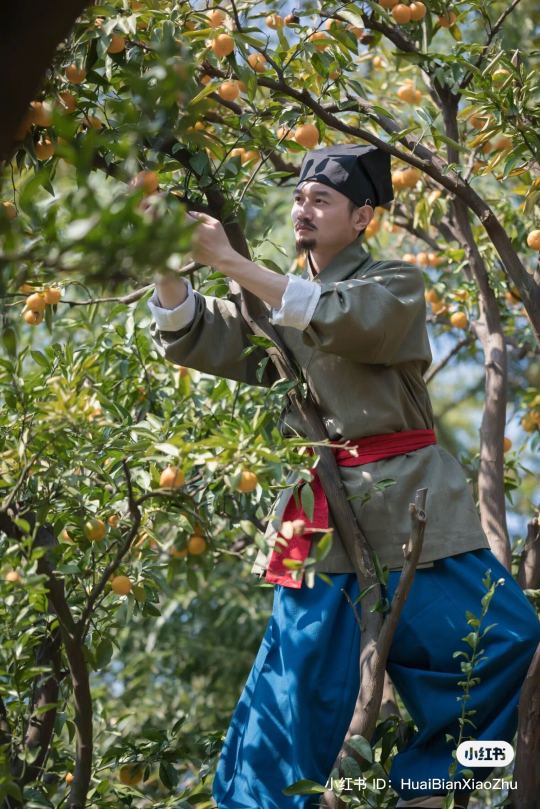
Yes, there is hanfu suitable for country folk who have to work in the fields and tend animals. Historically, such people would have worn a type of unisex hanfu called 裋褐/shuhe. Shuhe goes by a few other names, including 短打/duanda, 短褐/duanhe, and 竖褐/shuhe. They all refer to a two-piece set of attire composed of a cross-collar top that extends to the knees, coupled with tied trousers. Both pieces were typically made out of coarse cloth. It is the basis of almost all underclothing, usually the clothing worn under armor, and the casual outfit of commoners and laborers (x). This outfit was generally worn by people doing manual labor, such as farm work, and by martial artists (x).
I wrote about shuhe in my post on casual/adventurer-type hanfu here. For more information on shuhe, I recommend checking out the following links:
Wikipedia article on 衫裤/shanku
Patterns for shuhe-making
Shuhe-making tutorial
A few images of shuhe in historical art & modern day (1, 2, 3, 4):
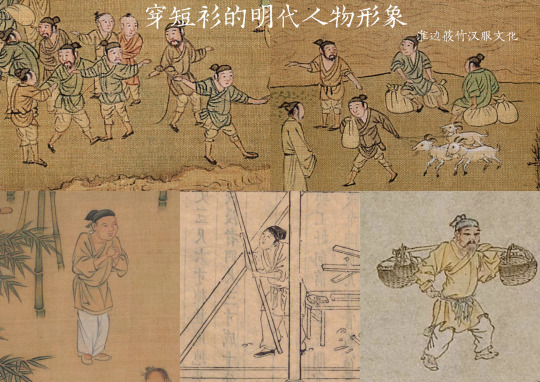
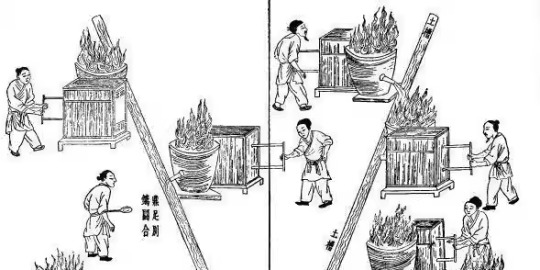
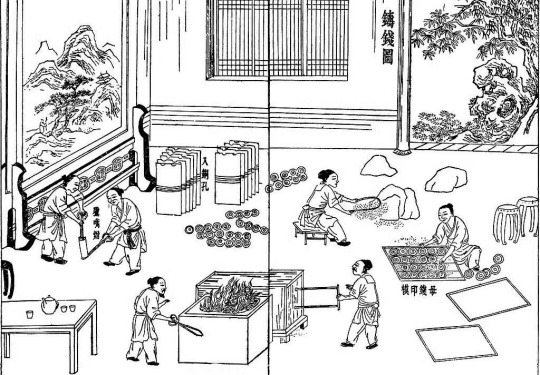

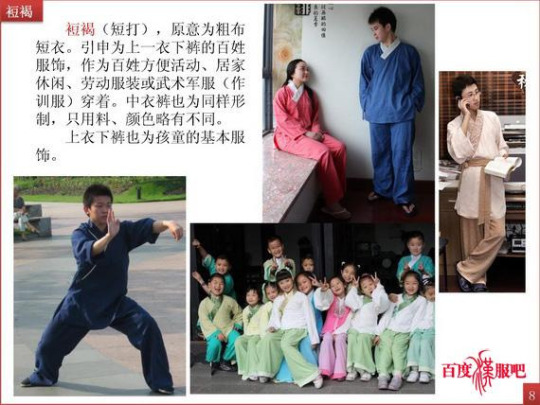
Shuhe understandably isn't as popular as other "fancier" hanfu styles, but there are still some available on Taobao, including the following:
Farmer-style shuhe for spring & autumn from 華夏节奏 (x):

2. Ming-style ramie shuhe from 淮边筱竹 (x):
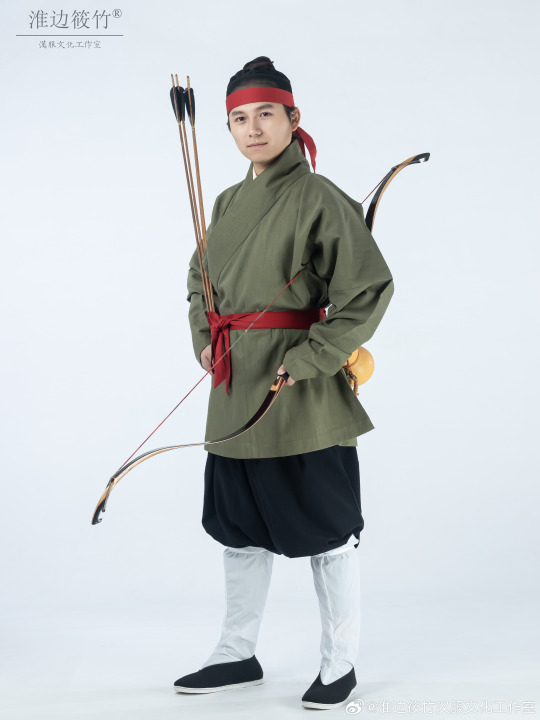
3. Tailor-made Ming-style shuhe from 淮边筱竹 (x):
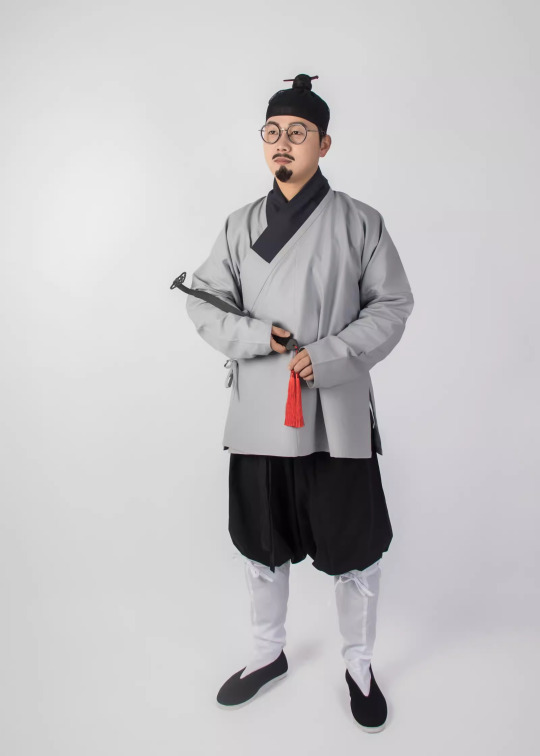
4. Ming-style quilted cotton winter shuhe from 淮边筱竹 (x):
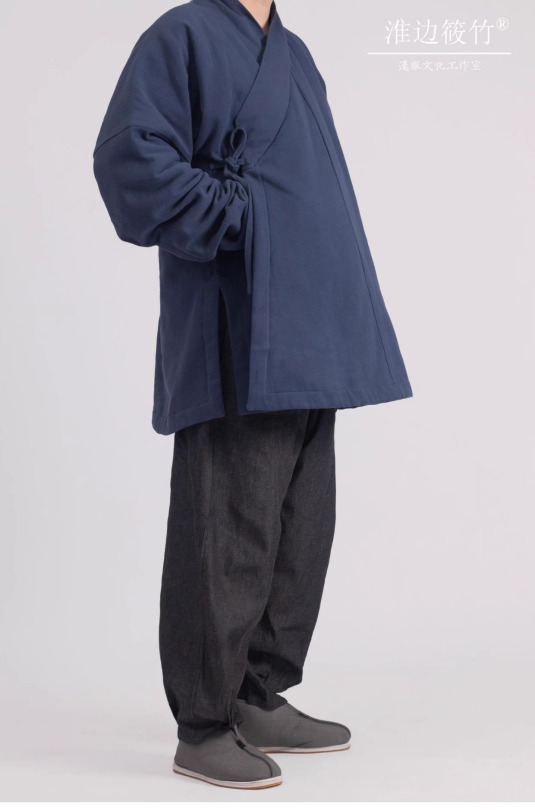
For more references, please see my shuhe and commoners hanfu tags.
If anyone has more info/recs, please share! ^^
Hope this helps!
#hanfu#shuhe#duanda#mens hanfu#commoners hanfu#hanfu recommendations#history#reference#ask#reply#lookadreygon#chinese fashion#chinese clothing#chinese culture#china
475 notes
·
View notes
Text
Band Nerd! Elf BF x Vocalist! Chubby Reader Part 5

Part 1-Part 2- Part 3- Part 4 -Old Taleisin Masterlist-More Modern Fantasy Stories/Current Masterlist
Synopsis: You find yourself revisiting passages in your history textbooks after some familiar names stick out to you while re-reading Taleisin’s journal page. Reader falls down a research rabbit hole on Taleisin’s family members, all while the Autumn Equinox gala is approaching.
WC: 3.5k

You couldn’t help but wonder about the journal page you had found yesterday.
You found yourself re-reading it yet again, fiddling with the page, the aged parchment crinkling between your fingers. The edge of the paper was uneven, hastily torn away. Two sentences standing out to you.
‘I don’t even want to go to the Magister’s Ball anymore.’
‘One of the Zarzaren brothers told me my father is paying Seren to be nice to me.’
A few words stood out to you, events and names referenced in history classes. You grabbed your music history textbook, flipping back to the photo of the harpsichord and reading the caption.
‘One of the harpsichords residing in Magisters Hill prior to its destruction during the Iirilethian Revolution.’
You knew the Magisters were the monarchy from long before the revolution, preceding the oligarchy that had recently fallen. Your music history class had discussed the Magisters Ball; a yearly ball that attracted the wealthiest and brightest in the country, where many iconic works were premiered.
“Why would he be there though?” You muttered to yourself, looking back at the page. You flipped to the index of the textbook, skimming the last column.
‘House Zarzaren, pg. 348’
The Zarzaren’s were one of the four noble houses that had fallen in the revolution, once owners of a powerful trading company that serviced the entire region. If he was talking, or feuding, with someone from that family, then surely he couldn’t just be a dorky saxophone player.
You were determined to learn more about him. You moved to your computer, looking up any related term that came to mind, yet you found nothing that related back to Taleisin. That’s when you realized you were missing a vital piece of information.
‘I can’t just ask him out of the blue what his last name is, that’d be weird. Would it?’ You weren’t sure.
That’s when you realized you were massively overthinking this. You minimized the historical tabs, and logged onto the learning management software your college used. You moused over to your literature class, clicking on a random discussion board you had completed before CTRL-Fing Taleisin’s name.
‘Taleisin Nerixi’
Immediately, you went to look up his name. There were no social media profiles, no hometown news articles, nothing mentioning Taleisin directly other than a Wikipedia article of someone sharing his last name.
‘Velathil Nerixi is an a Iirilethian scholar, scientist, and educator, best known for his discoveries on utilizing hemomancy safely.
‘Who the hell is that?’ You clicked on the article and CTRL-F’d Taleisin’s name once more.
‘He currently works as the Head of the Internal Magical Medicine Department at the University of Libreverde, teaching hemomancy, biomancy, and running the region’s most sought after hemomancy fellowship program. He resides within the city, living with his wife Gwendolyn Tenalver-Nerixi, and their son Taleisin Nerixi (b. 1457 2E).’
That had to be him. The year was 1559, 102 years after the date listed as Taleisin’s birth year. You looked over at the information under his father’s photo; he was obviously much older than Taleisin, listed as 652 years old.
‘Spouses: Saphielle Arendrel (m. 955 2E, divorced 1020 2E), Aurora Terin-Nerixi (married 1047 2E, died 1065 2E), Gwendolyn Tenalver-Nerixi (married 1439 2E).
“I suppose it’s not too strange for someone that old to have so many spouses…” you mumbled, unsure if his father’s amount of wives was a red flag or not. You noticed his second wife had a link to an article; you opened it in a new tab to potentially read later. You kept skimming through the article;
‘Before his discoveries in the field of hemomancy, Velathil Nerixi had a varied career working with all four noble houses during both the Illirie Theocracy and the Oligarchy of the Four Houses.’
Taleisin wasn’t the son of some duke or prince. He was the son of a man who simply worked for the nobility, for better or for worse.
You thought back to when you found the harpsichord keys, keys that looked suspiciously like the ones you saw in your textbook. The revolution was 87 years ago, he would’ve been fifteen when the grand estates met their end. You re-read over the page once again.
‘In my fifteen years of life, I’ve made only one friend.’
You couldn’t help but wonder where that one friend ended up.
Your thoughts were interrupted by the sound of your phone buzzing.
🧡: hiiii
You had a multitude of questions, but there was no graceful way to admit you had been reading Wikipedia articles about his family.
🩷: hey, how’s your parents house?
🧡: it’s good :D I got to see my cat
Immediately, you were distracted.
🩷: wait you have a cat :0
🧡: well it’s my dad’s not mine technically
🧡: but yeah! I’ll send a photo
You looked down at the picture he sent; a photo of an old black cat with white mittens, sitting peacefully on a windowsill.
🩷: he’s so cute! What’s his name
🧡: his name is mailbox
🩷: what
🧡: when we got him my dad let me pick the name and said to just tell him the first thing I thought of
🧡: that’s what I came up with
🩷: wow
🩷: he looks like a mailbox
🧡: you get it!
🧡: by the way uh
🧡: are we like. Good?
🩷: yeah, why do you ask?
🧡: I was thinking about the other day when you sent me the journal page
🧡: I don’t ever want to make people upset, and sometimes I do without meaning to
🧡: I mean, I never mean to
🧡: but sometimes people get mad at me and i don’t know why, and I don’t want to make you upset because I like you a lot and I don’t wanna fuck it up
🧡: but I might be fucking it up right now and not even realize it idk I’m probably just rambling
🩷: I don’t think you are
🧡: I just felt bad I might’ve made you feel bad
🩷: I just want you to be honest with me, that’s all. But I don’t hold that against you
🧡: to be honest it’s not that I wanted to hide it or anything like that, or lie to you
🧡: I genuinely didn't remember
🧡: like it was 80 years ago, and that time wasn’t…the greatest, to say the least
🧡: so there’s some like, lapses in memory
🩷: I get it, you don’t have to share anything with me you don’t want to
🧡: thanks :)
🧡: just, if i ever do something stupid please know I don’t ever intend to, I’m just bad at being a person
🩷: same
🩷: but I get it
It was clear he felt guilty. You had already pressed too hard, you wouldn’t ask him to divulge more than he already had. You looked back at the computer screen. In fact, you wouldn’t need to ask him anything else.
All the answers you could need were right in front of you.
—
The journal page didn’t come up again throughout the weekend. You had found article upon article about people he was related to, about their discoveries and accomplishments. Yet despite your curiosity, it felt strange to read them, as if you were intruding by doing so.
That Monday, there was a chill in the air on your walk to class. Flyers hanging off of notice boards informed you that the Dream Festival was approaching; a celebration on the Autumn Equinox to honor the God of Dreams, the ruler of the ninth month of the year.
The Dream Festival wasn’t just about the dreams one had when asleep, but dreams of their future, and honoring the dreams the Gods had allowed to come true. For those in university, both were worthy of celebration. The university held a gala every year, yet last year you didn’t get a chance to attend. You didn’t see a point in it; you had no one to go with, little money to spend, and far too much to do. Yet part of you wondered; would Taleisin ask you to go with him?
It’d be quite a romantic gesture, yet you still weren’t entirely sure what the two of you were. You had fucked, gone on a date, then an awkward confrontation over text about something that happened decades ago; something that happened long before you, or even your parents, were born. Was this why relatives cautioned against dating elves?
It wasn’t seen as immoral, certainly not illegal; elves and humans had been having relationships with each other nearly as soon as the Gods created them, long before magic even graced this plane of existence.
Yet even if you and Taleisin were on the same level intellectually, there was no doubt he’d have skeletons in his closet; anyone that old surely would. All sorts of rumors circulated regarding where remnants of the old noble families ended up; some said they used what remained of their wealth to flee, starting new lives far away from the island they once ruled. Some said they went into hiding, potentially re-emerging and living amongst normal society, the average citizen none the wiser. Some even said they worked for powerful criminal organizations, their greed undeterred by violent rebellion.
Given he was simply the son of someone associated with noble blood, you figured it could’ve been much, much worse.
You walked into class, Taleisin already there, two disposable coffee cups in front of him. “Hi,” he said, handing you one with a slight smile. It was warm; when you raised it to your lips you were greeted with the familiar smell of tea and honey.
“Hey, thanks,” you said before taking a drink, the tea warm enough to be comforting, but not scalding hot. “How was your weekend? Did we win?”
“Honestly, I forgot already,” he said with a nervous laugh. “I think so? But it was fun, I don’t see them often.”
“Your parents don’t actually live that far, right?”
He shrugged, “no, they’re pretty close, they live in the city. I don’t get to see them that often during the year unless I go over for the weekend, though. They’re both busy with work, and no one’s schedule really lines up. I don’t mind it though, and my dad works here, so if I really need to see him it’s not impossible.”
“What do your parents do?”
“Oh, my dad teaches blood magic, and then my mom’s an accountant.”
Throughout class, you looked over at the laptop screens of the people sitting in front of you. Looking at dresses, flowers, shoes; presumably all items for the Dream Festival.
It would be nice to be asked.
Yet given his history, and general personality, you’d understand if he wasn’t the type to attend such events. Still, you weren’t sure that the middle of class was the time to bring it up.
—
🩷: are you doing anything tonight?
🧡: not really, no
🩷: can I come over?
🧡: yeah! I can pick you up
When you arrived at his apartment, you found a large bag of individually wrapped candies sitting on the floor, four bowls beside it. He seemed to have been sorting them by color.
“Oh, uh…” he noticed your moment of confusion. “I uh, I’m really picky, I only eat the red ones. But I don’t wanna be wasteful, so I just sort them and give them to my friends.”
“That’s adorable,” you blurted out, a smile on your face.
“I should’ve put this away before I left, I’m sorry,” he mumbled.
“No, it’s okay. I uh…do you want some help?” You sat down in front of him, picking up where he left off as you sorted the candy by color.
“You don’t have to do that, I uh-”
“But I want to. If that’s okay with you.” If anything, doing something with your hands made conversation easier for both of you.
“Yeah, if that’s…yeah, sure.” He sat down, and you both worked your way through the bag of candy. “You can have whichever one you want, by the way.”
“Just not the red ones?” You teased.
“If you want, you can have those too.” He didn’t hesitate in his answer, yet his cheeks tinted red.
“I’m just kidding,” you leaned over, giving him a flirtatious kiss on the cheek. His eyes widened, a smile forming across his face. “I did wanna ask you, though…about the Dream Festival.”
He turned to face you, still taken aback by the sudden kiss. “What uh…what about it?”
“Well…what do you think about it?” You didn’t want to ask him if he outright had no interest in attending.
He shrugged, “I don’t know much about it, I get kinda nervous around big groups of people like that. Callon went, but the rest of us just hung out here and played video games. Alex was kinda moody the entire night though, I remember that.”
You were reminded of the somewhat obnoxious couple you saw at the performance. “Aren’t they dating?”
“Well, they weren’t then. Although maybe that should’ve been a clue…” he trailed off. “Apparently they started dating at the end of last year. I had no idea.”
Both of his friends seemed rather…open, about their relationship. “Really?”
“Yeah, it kinda came out of nowhere. Although…my dad said sometimes I’m oblivious to stuff like that. Like, people stuff. I guess I’m still not entirely used to talking to people so often. Or just being around them in general, I guess.”
You raised an eyebrow, “what do you mean?” His sentiments seemed a bit deeper than just typical social anxiety.
“Oh. Well,” he looked away for a moment. “I spent a lot of time just…staying inside. Like, I rarely left my room, much less the house. I didn’t talk to anyone that wasn’t my parents for a long time. It was…” he shrugged, “it was pretty bad,” he said with a nervous laugh.
You nodded, unsure how to respond.
The silence between the two of you didn’t last long. “Sorry. I shouldn’t have said all of that.”
“No, it’s okay. I…I just didn’t really know what to say. I don’t mind if you want to talk about it though, I’ll listen,” you shrugged.
“I mean,” he fiddled with one of the candy wrappers, “I don’t wanna like, bum you out. Basically…” you could tell he was choosing his next words carefully. “I don’t know, I kinda isolated myself for…seventy years? Maybe eighty? I don’t remember how long it was, to be honest.”
“…could I ask why?”
“It’s complicated, I guess. I uh…the short version of it, my dad worked for people that pissed a lot of people off. And they had good reason to be pissed off, but…I don’t know, he didn’t really have anything to do with that to my knowledge, he was just doing research with funding from one of the houses.”
“Your father worked with the nobility?” You already knew the answer to your question.
He nodded, “yeah, something like that. I…” he let out a sigh. “I don’t think what the nobles did was right, and I’m sure the world is a better place now, but…” he looked away, “when you turn on the TV, and stumble upon news anchors talking about whether or not your family deserves to die, it’s…scary.” He paused once more, “I don’t judge you if you think less of me. I probably would too, to be honest.”
You shook your head, “no, no it’s not that.”
“He’s not a bad person. My dad, I mean. At least, I don’t think he is. It’s a lot better now than it was decades ago, but sometimes they still get weird letters and what not,” he held his legs close to his chest, still fiddling with the wrapper. “I know I probably sound like some sort of freak, but…I was scared, you know?”
“I don’t blame you.” You moved closer, resting your head on his shoulder; a gesture that seemed to bring him a small amount of comfort. “You’re not your parents, or their decisions,” you shrugged, unable to verbalize your thoughts entirely. “I think you’re a lot braver than you give yourself credit for, though.”
He let out a quiet laugh. “That’s sweet of you to say, but…” he let out another sigh. “I feel like all my life I’ve been nothing but a coward, just hiding away.”
“If you were a coward, you’d still be in your room. But you’re not.” You offered him a reassuring smile. “You’re here.”
He didn’t seem to fully believe you, but he took the compliment regardless, leaning into your touch. “Thanks. But…yeah. Sorry, I didn’t wanna bring the mood down.”
“No, it’s okay, I’m the one who asked. We don’t have to talk about it anymore.”
“Thanks… Anyway, uh…what were we talking about?”
You smiled, “the Dream Festival. I…I was wondering if you’d like to go with me. As a date. But we don’t have to, I don’t want you to do anything you don’t want to do. I know it’s a lot of people, so I get it if you didn’t want to, we could always just do something here, or go back to the library with the cats.”
His eyes widened, thinking it over. He slowly nodded his head. “No, I wanna go. With you. If you want to go, then…then I want to go too. I’ve never really thought about doing something like that, but I’d like to try it with you,” he smiled. “It’s a lot of people, but…I can do it. I want to be as brave as you think I am,” he said with another laugh.
“Are you sure? We don’t have to, I won’t be upset if you say no”
“I’m sure. I want to keep challenging myself. Performing with you was terrifying, but I did it. Honestly, I got this weird sort of rush afterwards, like…’holy shit, I just did that.’ I want to keep doing things that scare me, especially if it’s with you.” He paused, “that sounds weird, I’m sure.”
“Not at all. I think it’s admirable. To be honest…I’m honored you’d do that for me.” It might not have been a big deal to some, but for him, attending the Festival would be a feat unlike anything else he had done in College; and he did it for you.
“Of course. You’ve given me a lot of confidence I didn’t have before, and I’m grateful for that. Even if it’s a bit nerve-wracking, I’ll endure it to share a dance with you.” He placed his hand over yours, and you couldn’t help but stare into his eyes; he was awkward, constantly nervous, yet he was forever grateful for you chasing him down in the hall, forever admiring not just your beauty, but your confidence and demeanor.
You rested a hand on his cheek, leaning in to kiss him. He returned the kiss, this time hesitating much less as he wrapped his arms around you. You moved onto his lap, kissing him deeper as you felt his hands move down your back.
You both eventually pulled away. He spoke back up, “the only other thing is uh…” he trailed off, letting out a nervous laugh. “I’ll be honest, my parents will probably be really annoying about it. I mean, not in a rude way, just…it’s been a really long time since I’ve done anything like that, so…they’ll be excited, to say the least.”
You let out a laugh, “I guess it’s worth asking then, if I’m going to meet your parents,” your own parents were hundreds of miles away, you wouldn’t need to worry about him meeting them for quite some time. “Are we…official? I mean, I know we said we’d see where things go, but…?”
“What do you mean? Like…officially together?”
You nodded, “yeah. Something like that.”
“To be honest…I’m still kind of in shock you’d want something like that with me. You’re so…” he gestured towards you, “well put together, I guess. I’m kind of a mess.”
You snorted, “I’m glad you think so, I certainly don’t feel that way. If anything, you’ve got things far more put together than I do. You’re not falling asleep in class every other day.”
“Well yeah, but you’re doing that cause you work hard, not cause you’re lazy.”
Admittedly, it felt nice to hear your efforts recognized, even if he had only heard you perform once. “Thanks. I…I appreciate that.”
“Of course. But um…yeah. I suppose we’re a thing now then, if that’s alright with you.”
“Is it alright with you?”
He nodded his head quickly, “definitely. I’d-I’d like that a lot.”
You kissed him once more, “I’d like that a lot too.”

HE’S SO CUTE AAAAAAA I JUST WANNA SQUEEZE HIM
This chapter was so sweet my teeth hurt. Also obsessed with reader being a bit of an fbi agent to learn more about him LMAO. Yay worldbuilding! I just really like the juxtaposition of “this guy has a lot more going on than he seems” with “yay school dance :3”
But yes, our sweet little saxophone playing elf boy is a recovering hikikomori with ties to very powerful people. His imposter syndrome go crazy.
Thank you for reading!
TALEISIN TAGLIST: @sketchlove @madam8 @shimadalluvia @crimsonflameproxy @mimi-sanisanidiot @damnitimasimp @dlikesdandelions @skeletonea @mysexy-anxiety
#eebeewrites#elf oc#elf x human#elf#taleisin#elf bf#chubby reader#elf x reader#x chubby reader#nerd love interest#modern fantasy#college au#band au#oc x reader#x reader
20 notes
·
View notes
Text
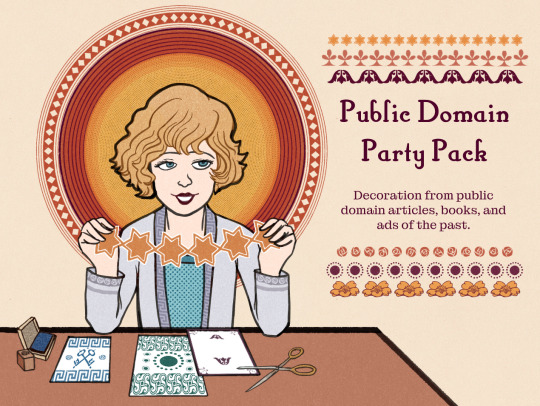
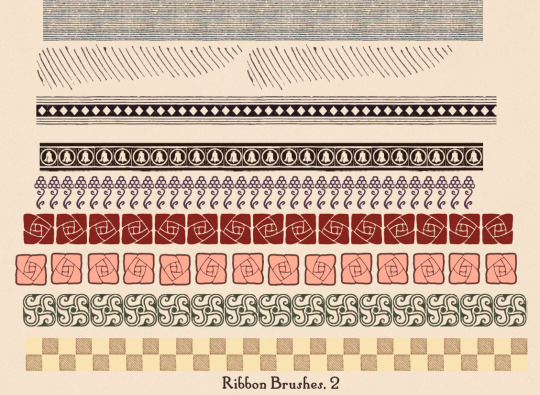
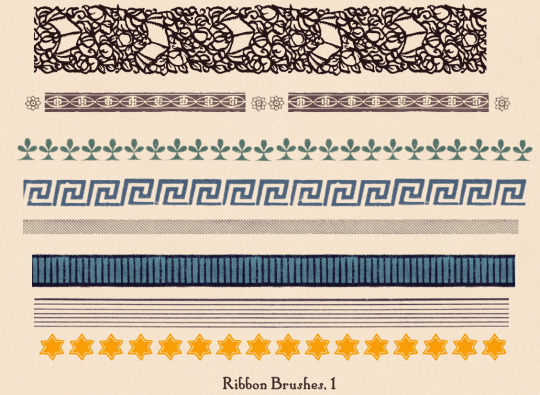

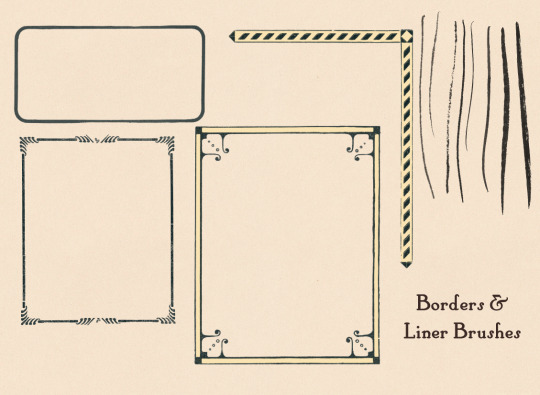
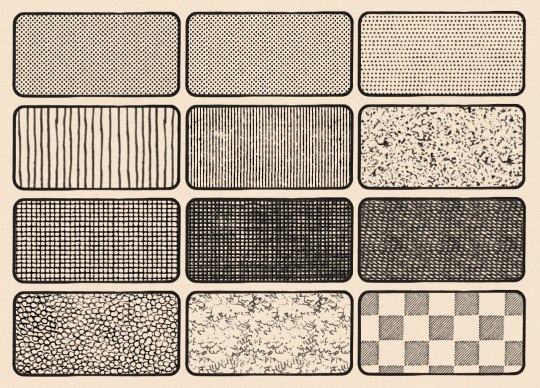
The Free Public Domain Party Pack
Mediafire | Ko-fi
I wanted to make a Clip Studio asset pack of public domain things I found on wikipedia while looking for inspiration & textures for my own stuff, so I did! These were made using various ads, books, & articles from the 1900s-1920s, so they're great if you're doing a period piece from those times.
The pack contains:
14 pattern fill brushes
8 Line Brushes
18 Stamps Brushes
17 Ribbon Brushes
+ a folder with a bunch of public domain paper (mediafire only bc it too big) & patterns, jpg & png

There is a .Psd file containing all the assets in the pack. This can be used & converted into brushes for any art program that can open .Psd files. If you do convert them, feel free to reupload them on your post (and link back to this or one of the other links so people can find the original Clip one if they want!).
#clip studio paint#clip studio paint brushes#edwardian#1920s#victorian#textures#texture#assets#clip studio paint brush#clip studio#public domain
43 notes
·
View notes
Text
The Republican Party is the bitch-ass party
Making a post just so I can say, where the Republicans on Tumblr might see it when they look away from their porn blogs: the Republican party is a part of cowards and traitors. Republicans in congress purposefully handed over their power to the president, violating oaths they took to the constitution, and are now standing in the way while Americans suffer--well, the working class Americans. The billionaires are doing fine. Better than fine. They now have our money while our prices go up and our services diminish.
And I'm not going to argue with you. Because I am arguing facts and you are arguing feelings. You can find the facts for yourselves. Each and every one of you can look up things like, tariffs, and insider trading, the percentage of taxes that billionaires (don't) pay compared to what you do, and that even people who came to America legally (which is your rule for how to do it) are being deported for speaking their minds--something guaranteed to all of us in that same constitution as a right. As the first right the founders wrote down because it was that important to them. And if legal citizens do not have any rights--then neither do you. You think being born here will save you? If someone did everything legally right and broke no laws and can still deported, then quite literally anyone can. If the president and congress and SCOTUS (well, Roberts) ignore the constitution, then you have no protections either. They can come for you whenever they want. They can take whatever they want from you, and you will have no legal recourse. You are now on the same level as the trans athletes you are all so afraid of, and every single undocumented worker who has been picking your produce during your entire lifetimes. You are now a citizen in name only, with rights that are no longer guaranteed.
You can look up all that shit yourselves the way you should have before you voted. And then you can look at your parents' savings, if they had any, and see what Trump's blatant market manipulation did to theirs, and you can look at their dwindling social security and medicard payments, how your job is now less safe (because DOGE cut OSHA), how they want your children to work backbreaking and dangerous labor, and receive less education so your children can never get better paying jobs (Department of Education now gone), and the lack of care for veterans at the VA (services also cut by DOGE), and the rising prices of everything because you didn't bother to learn about the global economy and how nearly everything "made" in America really comes in pieces from other places, and you can finally recognize that in choosing to vote for a hateful man because he temporarily made you feel better, you are about to feel a lot worse.
Look up every thing I just mentioned, look for information from more than one source and do not use a "news" service that has been sued (and lost) because it lies so much. (I mean Fox News). Do your own research. Go to a library and ask them about tariffs. Or even go to wikipedia, and then read the articles they link to.
Republicans do not want you to read that information. That is why they are attacking libraries and education (and why Elon Musk hates wikipedia so much).
You really gonna let the current Republican party, the party of cowards and traitors who handed over their power to the president, tell you what to do and what to think?
#maga#trump#president trump#republicans#gop#for once i agree with the libertarians in that you should never blindly trust any government#but especially not this one
22 notes
·
View notes
Text
shido's conspiracy is big: koenkai (supporters associations) in japanese politics
How do you take over Japan, if you're a corrupt piece of shit?
On 11/25, when the Shido's Palace mission starts and you're finally released from captivity in Leblanc, the Modest Housewife in the Shibuya underground mall suddenly becomes the Not-So-Modest Housewife. And what does she tell us?

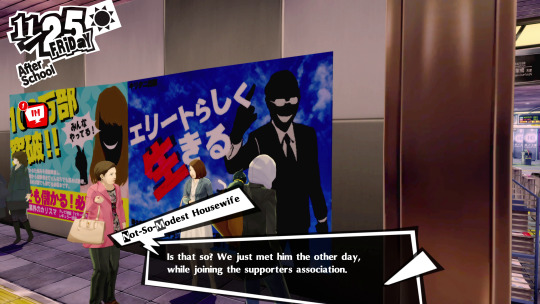
shido has a what now
What's the "supporters association"? In Japanese, it's a 後援会 kouenkai. From Wikipedia:
Koenkai (後援会, lit. "local support groups") are an invaluable tool of Japanese Diet members, especially of the Liberal Democratic Party (LDP). (note: in P5, this is the "Liberal Co-Prosperity Party" or LCP, Shido's original party and the original ruling party.) These groups serve as pipelines through which funds and other support are conveyed to legislators and through which the legislators can distribute favors to constituents in return.
The article is fascinating; do give it a read, as I can't possibly do it justice here. These are massive organisations, and relay vast amounts of cash to their members. They organise endless activities for their members—that meeting at the Wilton Hotel on 5/5 is one. They often require a personal connection to be invited, which is why the Housewife says this to her friend:
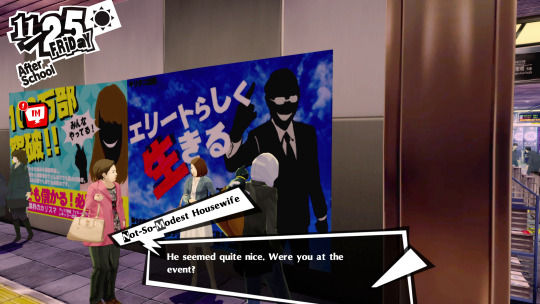
... she knows she wasn't invited.
Though koenkai are weaker in modern times, there are many examples of them being involved with corruption; here are a couple.
"The Asahi reported in the mid-1970s that the [koenkai of former Prime Minister Tanaka Kakuei] "virtually controls… agricultural committees, popular welfare committees, election management committees". This thorough penetration of Tanaka's koenkai into all important facets of Niigata's people's lives propelled him into becoming the father figure of the district. After his arrest in 1976 on corruption charges, many of Niigata's residents still expressed deep respect towards him."
"Due to the huge support [former Prime Minister] Takeshita Noboru enjoyed as a result of his koenkai, his electoral district in Shimane came to be known as ‘Takeshita Kingdom'. Despite being embroiled in many political scandals, related to insider trading and corruption (for which he was never charged), Takeshita's immense local support never waned."
so what does this tell us
In short, Shido's conspiracy is not a few corrupt high-level officials. It's not just Shido, Akechi, the SIU Director and those people on the ship. It is a vast organisation.
It recruits people by reputation (remember those five recommendations in the Palace?) from all levels of society—and those recruits then operate as a bloc, networking, doing favours for each other, advancing their mutual interests, connected via a hierarchy to Shido at the top. This is why Shido can control everything.
It also explains why everyone seems to be linked to the conspiracy—including the hapless Principal Kobayakawa. Did you think it was unrealistic for him to be involved? It seems likely that he was just a low-level member of Shido's koenkai.
When Shido needed someone at Shujin to investigate the Phantom Thieves, Kobayakawa was there—because they have people everywhere. A quick phone call from a higher-up in the organisation—the SIU Director, most likely, who we know Kobayakawa speaks to—and he's eating out of Shido's hand. And will do anything he wants....
So Kobayakawa wasn't anybody at all. He wasn't important. He wasn't somehow part of the deep state. He was just one of likely hundreds of thousands of paid-up Shido supporters looking to advance themselves, getting the vote out, and funding the cause.
He was in the right place at the right time. After all, the koenkai got Kobayakawa his job at Shujin. All his hopes for advancement are centred on it:
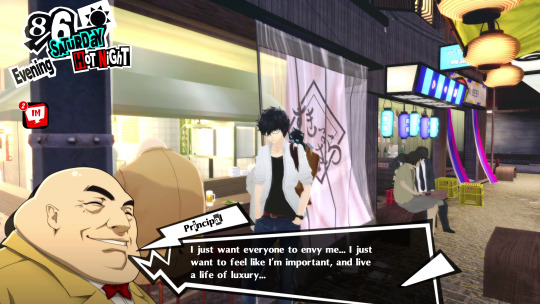
Because just like the two housewives in the underground mall, and probably like everyone else in the koenkai, Kobayakawa is a desperate social climber, impressed by wealth and fame and power and flashy titles.
I hope he thought it was worth it.
revision history
Click here for the latest version.
v1.0 (2023/10/31)—first posted.
250 notes
·
View notes
Text
Virtue - Day 178
Race: Divine Alignment: Neutral-Law Arcana: Justice April 9th, 2025

SMT has some of my favorite interpretations of angels in any piece of media- while not taking directly from the Old Testament and their overdesigned and incomprehensible appearances, instead, the series pulls a unique spin on each one of their basic concepts and everything that goes into them to make them fascinatingly unique. Even the weaker designs like the Archangels still fit and aren't just boring winged humans, I'd argue, and this kind of heavenly creativity is shown best in some of the more esoteric angels throughout the series. After all, when you think of an angel, you just think of a human with a halo and wings in most cases, unless you're rather online. Shin Megami Tensei, on the other hand, decided to take that basic concept and morph it completely. Case in point, today's Angel of Today, the Virtue.
Of the nine choirs of angels, Virtues are some of the least understood, as they're mentioned a scant few times and given very little to work off of in the original text. This is where it's worth noting that most Angelology, as we know it today, doesn't directly originate from the Bible- instead, it mostly originates from the text 'The Etymologies of Isidore of Seville,' and this becomes specifically important with Virtues, as the name virtue referring to an angel is actually a mistranslation and, on top of that, they aren't directly referenced in the Bible. Also, sidenote, the sources on this are fucking wild. Like, one of the first results that pops up is a fandom wiki for a Deltarune crossover fanfiction called 'Cronianverse' with an AI Generated page about this very topic. I'm not joking. Still, Virtues aren't actually referenced in the bible as far as I can tell, and most (if not all) of what we have to work with when it comes to Virtues comes from the Etymologies.
What does the text have to say about Virtues? It describes them as being in the second order of angels, the same one that has Dominions and Powers, being the fifth choir overall. Within the Etymologies, Virtues are described with Powers, being the metaphorical shield to the Powers' sword- they protect humanity from evil's influence, while the Powers defeat evil itself. Their alternate and less common (but seemingly more accurate) name, 'Strongholds,' also reflects this. To, uh, say it less confusingly, Virtues seem to have the ability to basically grant people with power, grace, and righteousness, and they can also dispense the grace of God to people who pray to them.
Past this, they also watch over and ensure that the stars and the moon, as well as the other celestial bodies, function properly. Angelic NASA, I suppose. Their last major role is actually in being able to watch over and control nature, but unfortunately, the link for the article this was gotten from on Wikipedia is dead. I was, however, able to Wayback it! Yay! Unfortunately, what it directly says about them controlling nature is basically a simple note saying, 'yeah, they can control nature.' To quote,
Other sources call them “the shining ones,” perhaps because of their control over the elements of nature, such as storms.
...who are these other sources? WHO ARE THESE OTHER SOURCES, PATRICIA?!
Jokes aside, though, the idea of Virtues as a steadfast beacon who can protect humanity is reflected fantastically in their design in SMT. I'm in love with how they appear as translucent statues of typical angels with beating, bleeding hearts wrapped in thorn, a common trait of many biblical things due to the crown of thorns that Jesus wore during his execution. Their appearance as a statue and even the way they're completely unmoving in the 3D games shows them as being the most literal definition of an unmovable wall without them literally just being a wall- an angelic statue with its heart behind its glassy skin. 10/10, no more notes. I love this design.
16 notes
·
View notes
Text
Grim Fandango: Art Style
Grim's art style is actually really interesting!/gen It stands out in multiple ways, but mostly in the character designs.
Made at a time when 3D models in games were still very blocky, Grim managed to use this limitation to its advantage. The character designs are heavily inspired by Mexican folk art.
The skeleton characters were modeled after calacas, colorfully exaggerated figures of skeletons made from wood, clay, or, as far as I can tell, whatever other material you can think of. Calacas tend to be highly stylized, with more exaggerated shapes and proportions than real skeletons. They notably translate very well to animation such as in Book of Life, Coco, and Monster High, and Grim Fandango is no exception. Their simpler, more distinctive shapes can actually be captured really well with Grim's blockier, less refined models.

Mariachis in Grim Fandango.

Real mariachi calaca figures.
The same goes for a lot of the monsters, which seemed to be inspired by alebrije figures. (If you've never heard of alebrijes, check out this article! They're super cool!/gen)

Monsters from the Sea of Lament in Grim Fandango.

Image from the alebrijes Wikipedia page.

One of the cats from the Cat Tracks in Rubacava.

An alebrije from this article.
Alebrijes rely on striking and dramatic shapes and vibrant colors, meaning that, like the calacas, they mesh surprisingly well with early 3D graphics.
Now, according to the developer commentary in the remastered version of the game, the demons and some of the vehicles, Glottis and the Bone Wagon in particular, were inspired by the work of the cartoonist Ed Roth. (His Wikipedia page here if you're interested!) I wasn't familiar with Ed Roth prior to playing Grim, but after looking up his work, yeah, I see the influence!

Glottis and the Bone Wagon.

An Ed Roth piece.
Grim's models and textures aren't nearly as detailed, but the spirit is there!
All-in-all, just like with everything else, Grim Fandango's art style bursting with charm and personality that more than make up for its outdated graphics!
Link to the complete review!
#grim fandango#lucasarts#pc games#point and click#adventure games#tim schafer#glottis grim fandango#glottis#ed roth#calacas#alebrije#my posts
20 notes
·
View notes
Text
I could list a lot of weird stuff Catholics do since I grew up as one, but it turns out that there are some things that I thought were normal on a catholic scale but turned out were a local phenomenon.
CW: skeletons, bones, mummified body-parts
May I present to you: Catacomb Saints

Von Richard Mayer - Eigenes Werk, CC BY-SA 3.0, Links
This is the first one I saw as a child on a school trip to a local abbey, and it made a lasting impression. The memory came back up recently, and I went on a deep dive.
One thing catholics love are their saints. If you are from a family who take them really seriously, you even got a gift on the saint day of the one you were named after, and my grandparents still tell me that it was more important than a person's birthday (I always got something small). Churches are pretty serious about their relicts and keep them in richly decorated Reliquaries.
You could guess what would happen when a church got hold of a whole saint skeleton: They decorate it. And turns out, the ones I knew are pretty "basic".
While a lot of them also wear clothing, they are usually covered in gemstones and gold.


Von © Jörgens.mi, CC BY-SA 3.0, Link Von DALIBRI - Eigenes Werk, CC BY-SA 4.0, Link
Some of them even have reconstructed body parts:


Von Mrilabs - Eigenes Werk, Gemeinfrei, Link Von Andrew Bossi - Eigenes Werk, CC BY-SA 2.5, Link
And of course: Skeletons wearing armor:

Von Dbu - Eigenes Werk, CC BY 2.5, Link
You may ask yourself: why?
Relicts are incredibly important. Even more if they connected to an early Christian martyr. The Catholic Church differentiates between three types:
First-class relicts: The best relicts. These are items directly connected to the life of Jesus. Most popular would be the Shroud of Turin, one of the several Veils of Veronica (Wikipedia lists 4), the Holy Grail or his foreskin (lost but in history claimed to have it often multiple at the same time). The physical remains of a saint, especially martyrs, are also First-Class with. These are often small pieces. Often single bones, hairs. If you are lucky, you get a full limb.

By Andrzej Otrębski - Own work, CC BY-SA 4.0, https://commons.wikimedia.org/w/index.php?curid=54797117
Second-Class relicts are items owned or used by a saint, think clothing (scraps) or crosses
Third-Class relicts are items that came in contact with a first- or second-class relict
And now imagine that your church could house a whole skeleton.
Starting in the 7th century, some churches got the permission to exhume the graves of martyrs. You had to get the permission of a bishop in Rome, and the skeleton came with a certificate of authenticity. Additionally, you had to contact a convent and have them prepare the Relict.
Important: These were (probably) real martyr skeletons.
Then the reformation happened. In the 16th and 17th century, a lot of catholic churches had their relicts (and paintings) stolen and destroyed. After the so-called Iconoclasm died down, the churches needed new relicts and the pope ordered to exhume thousands of remains from the catacombs in Rome. Some of these might belong to martyrs, but if they didn't know the identity of the buried person, they chose a saint and backstory. Most of them ended up in Switzerland, Austria and south Germany. Sale of them was (of course) illegal, but that didn't stop them to charge fees for the transport and decoration.
The trade with relicts was finally banned in 1860 and around this time people started questioning these relicts. Due to this, a lot of them were destroyed or hidden.
But they still exist. They are a bit hard to track down. The ones I saw as a child aren't mentioned on the churches Wikipedia nor on the churches' website. I found a church near me that houses two, but apart from a few articles they are mentioned nowhere. The German Wikipedia page has a list of churches, but after clicking through most of them, only a fraction mention their skeletons. My university library has a book on them that apparently contains a more complete list, and I need to check it out. Another great source is Paul Koudounaris´ Heavenly Bodies: Cult Treasures and Spectacular Saints from the Catacombs, that I need to get since it has a lot of photographs. And I need to visit some churches.
Additional Reading:
#german stuff#crypt saints#catholiscism#christianity#macabre#skeleton art#catholic saints#is this grave robbing?#such a strange concept but as a child i ate it up#there is a church that has 10(!) and I already looked up some train connections
11 notes
·
View notes
Note

???
you can in fact very easily google this but on many occasions a number of people were encouraged to / had no choice but to utilize MAID because the government doesn't provide sufficient funds for disabled people. in fact (and this is on the wikipedia page!) a number of people have been told to consider MAID (in one case even being shamed for not doing so!) in situations where it was entirely inappropriate. it's a eugenics program and is often the only option for poor disabled people.
some reading on the matter (again. i just googled these and skimmed them to make sure they were correct. the jacobin one i had already read but still. incredibly easy)
within these links you can see examples of people choosing maid to escape non-consensual institutionalization, choosing maid because they are not provided any affordable options, etc. it's despicable and i think making a cheery catgirl joke about it is irresponsible at best and reprehensible at worst
7 notes
·
View notes
Note
hi there!!! love your art first of all!! :)
i came across a rb of your cotton cieling/peaking comic (which i also love!) and saw in the notes how tims have scrubbed the tag since then. it made me curious how widespread the knowledge of their rape rhetoric actually is (since we know how happy they are to spew it when they know only lesbians are reading/listening, but we also know how hard they try to pretend to everyone else that they're tooootally not homophobic and toooootally don't have an incel meltdown at the mere thought of a lesbian saying "no" to them)
so i decided to see if wikipedia had an article on the ""cotton cieling"" (god i could go off on one about how these misogynists think "women are not given equal positions/mobility in the workforce" and "men get told 'no' by women they want to have sex with realllllly badly :-(" are at ALL comparable but this ask is long enough already) and guess what!? they DO but it has been NUKED to all hell.
right now? it's got zero citations/links, zero name drops of any Brave And Stunning men who promote it and write theory about it let alone naming the POS who coined it, barely even says what the definition even is... it's THE shortest article i've ever seen on there.
but look at the history tab!!! it used to be a fleshed out piece that was out and proud about claiming "lesbians not wanting to sleep with men is both oppressive and misogynistic" until at some point they realized saying the quiet part out loud where "normies" might see it was not a good idea and quietly scrubbed the article. (but they still keep it up!! as opposed to that female mod who made literal thousands of helpful factual edits, maintaining their site for free: she got banned the moment they found out she wasn't a handmaiden and all her work is theirs now i guess). and all the while, in the background, they've kept on coercing and pressuring lesbians to sleep with them nonstop with zero guilt or shame.
please for the love of god explain to me how they've convinced anyone who pays attention they're ""the most oppressed minority group who ever lived""???
holy shit anon you're right, that edits tab is crazyyy. They have definitely done a 180° on this subject, at least out loud where the average person can read it. The discussion page is another good read, LauraRichards1981 if you ever read this, you are a star and I love you.
Talking to other feminists and others who used to support genderism but "peaked", I would say at least half of them brought up the phenomenon of trans-identified men insisting lesbians have sex with them or be labeled bigots as at least one factor in their new outlook. It's so blatantly homophobic and I think a lot of influential figures in trans activism have realized how bad it looks for them, and have actively tried to memory hole it. I have even seen some claiming that "terfs" invented the term, which is hilarious because, as portrayed in my comic, I saw it with my own eyes being touted absolutely everywhere online as a way to vilify lesbians who wouldn't go along with every desire of the male trans individuals who had parasitized their communities. The DARVO is real.
50 notes
·
View notes